OPPORTUNITY AND CHALLENGE
The Story of BLM
|

|
|
THE SEARCH FOR AN IDENTITY:
The Bureau of Land Management, 1946-1960
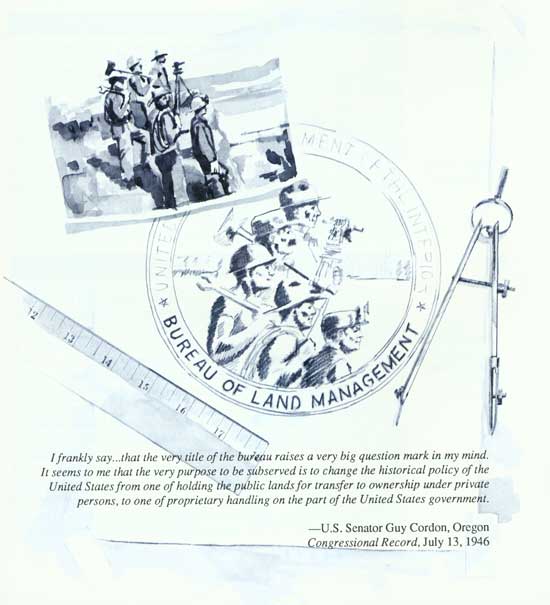
"I frankly say...that the very title of the bureau raises a very big
question mark in my mind. It seems to me that the very purpose to be
subserved is to change the historical policy of the United States from
one of holding the public lands for transfer to ownership under private
persons, to one of proprietary handling on the part of the United States
government."
—U.S. Senator Guy Cordon, Oregon
Congressional Record, July 13, 1946
|
THE SEARCH FOR AN IDENTITY
The Bureau of Land Management, 1946-1960
|
|
|
The Bureau of Land Management (BLM) from 1946 to 1960
was an agency in search of an identity. The executive reorganization
creating the Bureau simply merged the General Land Office (GLO) and
Grazing Service. BLM had no new mandate, only the authorities and
functions of its predecessors.
The first years found the agency struggling to
survive. It was hindered in its organization effort and haunted by the
Grazing Service's fee increase debacle. There was serious question as to
whether the agency would survive.
|
|
Overview |
|
In 1948, a new Director, Marion Clawson, brought life
to BLM. Clawson laid the foundation for effective public land and
resource management. BLM decentralized administrative and resource
management functions, recognized resource interrelationships, and
stressed the importance of land classification and planning to multiple
use management.
Clawson was succeeded in 1953 by Edward Woozley. The
new Director's conservation philosophy differed from that held by
Clawson, but the basic thrust of better management through
decentralization and multiple use development remained. By the end of
Woozley's 8-year tenure, BLM had matured into a professionally competent
land managing agency.
|
|
|
THE MERGER
|
|
|
The Bureau of Land Management came into being when
the General Land Office and Grazing Service ceased to exist—the
direct result of the Reorganization Plan No.3 Act of 1946. To head the
new agency, a Director was to be appointed by the Secretary of the
Interior. Unlike predecessors in the GLO and Grazing Service, who were
presidential appointees, the new agency chief was to be selected under
the classified civil service system. Also to be appointed were an
Associate Director and "so many Assistant Directors...as may be
necessary."
|
|
Reorganization
Plan No. 3
Act of 1946 |
|
The Reorganization Plan, however, did not provide a
mandate for the newly formed agency. BLM was simply placed under the
Secretary of the Interior and "the functions of the General Land Office
and Grazing Service...consolidated to form a new agency." The Bureau,
therefore, had to continue administering the public lands using the
outmoded and often conflicting mandates of the 3,500 laws passed during
the previous 150 years. The major statute directing BLM activities was
the Taylor Grazing Act, which provided for the administration of grazing
"pending final disposition" of the public lands. 'This [was] hardly
a firm basis," as natural resources professor Sally Fairfax points out,
"for a comprehensive land planning management scheme."
|
|
No Mandate |
|
Another problem facing the Bureau was the integration
of the General Land Office and Grazing Service into one organization.
BLM resulted from a merging of the oldest federal agency with one of the
youngest—two agencies with different organizational structures and
philosophies. GLO was centralized, with most authority placed with the
commissioner; the Grazing Service was decentralized. The General Land
Office handled a variety of resources, while the Grazing Service dealt
primarily with range management. Creating a new organization out of
these two agencies posed a challenge.
|
|
GLO and
Grazing
Service
Differences |
|
THE EARLY YEARS
|
|
|
BLM struggled in its first two years to simply
survive. A new organizational structure was outlined, but attempts to
put it in place were hindered by congressional opposition. The nightmare
of the Grazing Service appropriations debacle also haunted the
agency.
|
|
|
Fred W. Johnson, who had been Commissioner of the
General Land Office, was selected by Secretary of the Interior J. A.
Krug in 1946 to be the Bureau's temporary Director. Johnson was in poor
health and did not promise to be an effective leader, but Krug
undoubtedly felt selecting the Grazing Service's Clarence Forsling would
only have continued congressional attacks. To assist Johnson, Krug
turned again to the former GLO. He appointed Joel D. Wolfsohn, the
former Assistant Commissioner who had directed GLO activities for
Johnson, to be Acting Associate Director, and Thomas Havell, a long-time
GLO employee having good relations with Capital Hill, to be temporary
Assistant Director. To Wolfsohn and Havel would go the task of molding
BLM into an agency.
|
|
BLM's First
Director |
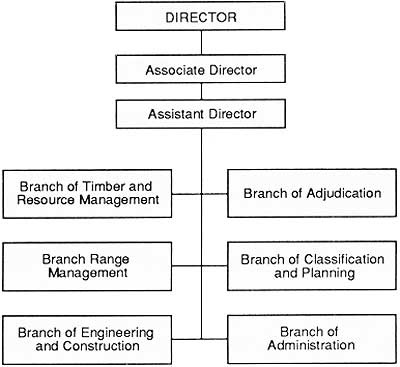
|
|
BLM organizational structure in 1946
|
|
|
|
BLM's organization called not only for the
integration of General Land Office and Grazing Service functions and personnel,
but also for improved public land administration and public service
through decentralized operations. A three-tiered organization was
outlined which featured a Washington office headquarters and regional
and district field offices. Headquarters arranged itself around the
Bureau's major functions— range management, timber management, land
and mineral adjudication, classification and planning, survey and
engineering, and administrative services. The field offices were
organized around the Grazing Service's district office system, as well
as the GLO's Oregon and California (O&C) forestry offices and land
and survey offices. With this type of organizational structure, the
agency could maintain on-the-ground management of public lands and
resources; public land users could get on-the-spot handling of
administrative matters.
|
|
BLM's
Organization |
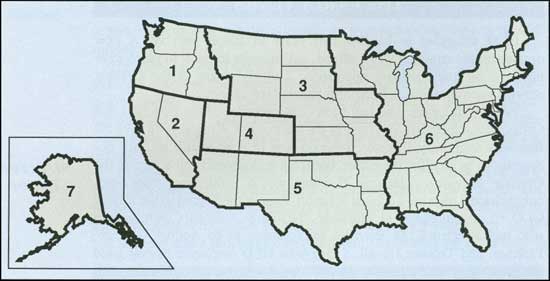
|
|
BLM regions in 1946
|
|
|
The key to BLM's proposed organization, however, was
the regional offices. The Bureau of Land Management hoped, as director
Johnson stated, to furnish "better service...through regionalized
handling of cases...affording wider opportunity than ever before for
resource development under prudent conservation safeguards." This meant
delegating Washington office adjudication functions to regional
administrators.
|
|
|
Seven regional offices were established, each
responsible for more than one state. These were used in place of the
single-state setup employed by the Grazing Service so that state
political and economic interests could not dominate regional personnel.
Congress, however, prevented the transfer of responsibilities from
Washington, arguing that the Bureau's regional offices would strengthen
bureaucratic control over public lands and user groups and hinder
congressional oversight of the agency's actions. Therefore, in the
Interior Appropriations Act of 1947, Congress banned the "transfer or
removal of any function or duties...heretofore held and administered in
[Washington]...unless specific approval [had] been given by
Congress."
|
|
Congressional
Opposition to
BLM
Organization |
|
Congress addressed another major concern in the
Appropriations Act. The very name of the agency—the Bureau of Land
Management—aroused suspicion among some western politicians. They
believed, as Senator Guy Cordon of Oregon did, that the agency's title
implied abandoning the nation's long-held policy of transferring public
lands to individuals and private interests in favor of a policy of
federal retention and proprietorship. Congress, consequently, directed
Bureau funds be used for the "disposal," as well as the management and
protection of, public lands, something that had not been done in recent
General Land Office and Grazing Service appropriations acts.
|
|
|
The Bureau's organizational efforts also suffered
from the Grazing Service fee increase controversy. Congressional
appropriation cuts gutted the range management program. With 86
personnel to oversee 150 million acres of grazing land, BLM could not
effectively process grazing applications, monitor range conditions,
prevent trespass, or build range improvements.
|
|
Solution to
Grazing Fee
Controversy |
|
The grazing district advisory boards, fearing a
breakdown of order on the public range, stepped in. Using monies
received from Taylor Grazing Act fees for range improvements, the
advisory boards paid the salaries of BLM range employees. Having the
advisory boards pay agency employee salaries put the Bureau in an
awkward position. "In effect," as political scientist Phillip O. Foss
notes, "the regulators were being supervised by those who were to be
regulated." BLM needed to be independent if it was to perform its duties
properly.
|
|
|
Secretary of the Interior Krug understood this. From
talks with western livestock interests, he knew that ranchers would
accept a slight grazing fee increase. To study the situation, Krug
appointed California rancher Rex L. Nicholson. Nicholson concluded that
BLM needed only 242 people to adequately manage the public range. He
recommended increasing the grazing fee from 5 cents to 8 cents per
animal unit month (AUM). Two cents were to go for range improvements,
with the remaining 6 cents to be distributed between the states and the
Federal treasury. The federal government's share of the fee covered 70
percent of range administration costs—those functions benefiting
only users. The remaining 30 percent— programs of general public
good—would be funded by Congress. The National Advisory Board
Council accepted Nicholson's formula and, in 1947, Congress gave its
approval to the grazing fee increase and distribution plan.
|
|
The
Nicholson
Plan |
|
The plan, however, did not help BLM. Congress could
not adequately fund programs not covered by grazing fees. This, and the
fact that Nicholson's administrative cost estimates were too low, left
the Bureau's range management program little better off than before.
Thus, the Bureau's beginnings were not auspicious.
Its inability to implement an organizational structure and secure
adequate funding made it ineffective. Secretary of the Interior Krug
called BLM "one of the...worst run Bureaus" within his Department.
Employee morale was low. Many employees, particularly in Washington,
looked upon their work as simply a job, and few had a sense of
dedication. The future looked bleak, but a new Director would soon turn
the situation around.
|
|
MARION CLAWSON: A SENSE OF MISSION
|
|
|
The Bureau of Land Management was invigorated in 1948
with the appointment of a new Director. Western ranchers and
congressional supporters did not feel Fred W. Johnson was sufficiently
attuned to their needs and demands. Secretary of the Interior Krug
agreed new leadership was needed but rejected suggestions of livestock
interests for a new Director. He wanted someone who would be accepted by
stockraisers, yet would exercise independence. He turned to Marion
Clawson.
|
|
Search for
New
Leadership |
|
Clawson was BLM's regional administrator in San
Francisco. He had joined BLM in 1946 after many years with the
Department of Agriculture's Bureau of Agricultural Economics. A Nevadan,
Clawson had an undergraduate degree in agricultural economics from the
University of Nevada and a doctorate in economics from Harvard. He also
understood the ranching business. His father had a small ranch in Nevada
and his dissertation at Harvard had been on the economics of the western
livestock industry.
|
|
Director
Marion
Clawson |
|
Clawson did not think his work at BLM was challenging
and was disheartened by the agency's inability to decentralize and
secure adequate funding for its programs. He was searching for other
work when Joel Wolfsohn, who was resigning, asked him if he wanted the
Associate Director position with BLM. Clawson declined, commenting that
he would not be able to accomplish anything unless he was Director. Soon
afterwards, Interior Secretary Krug offered him the directorship.
|
|
|
The Secretary bluntly told Clawson that he considered
the Bureau of Land Management to be poorly managed. Krug made it clear
to Clawson that the agency needed new blood if change was to be made.
Clawson had his mandate—to transform BLM.
|
|
Mandate for
Change |
|
Clawson's first task was to reorganize the Bureau.
Assistant Director Thomas Havell had to go because of his "old GLO"
attitude. So did the chiefs of most of the branches. Clawson replaced
these people with individuals from outside BLM. For Assistant Director,
and later Associate Director, he selected Roscoe Bell, who had worked
many years in the Department of Agriculture. Clawson filled a number of
other positions with people he had known in the Bureau of Agricultural
Economics.
|
|
|
Director Clawson pursued decentralization. He
believed strongly that decentralization was essential if BLM was to
become effective, efficient, and responsive. Clawson convinced Congress
in 1948 to remove most of its restrictions against delegating authority
to the regional administrators. The next year, no restrictions were
imposed; by the end of fiscal year 1949, 85 percent of the Bureau's
adjudicative functions had been decentralized to the regional and
district offices.
|
|
Decentralization
of BLM
Functions |
|
Clawson's reorganization made Washington responsible
for overall supervision and development of long-range management and
conservation programs for the public lands. The Director's technical
expertise rested with the Washington office's six branches, which he
transformed into divisions and subdivided into other branches.
Beneath the Washington Office came the regions.
Regional Administrators were directly responsible to the Director. The
regions handled most case adjudications and developed the long-term
plans for the public lands and resources within their jurisdictions.
Regional staffs were organized along lines similar to those of the
Washington Office and provided technical advice to district offices.
|
|
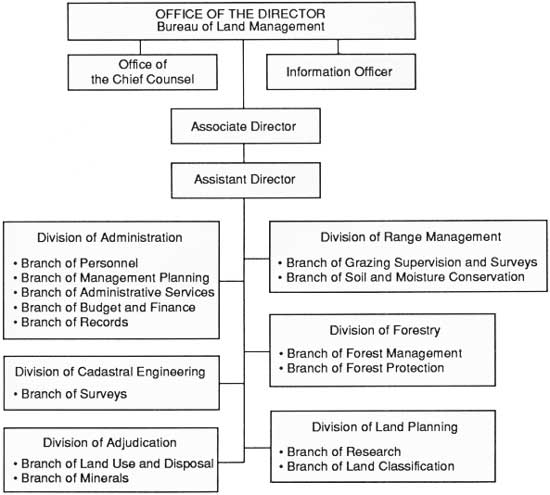
|
|
BLM organizational structure in 1950
|
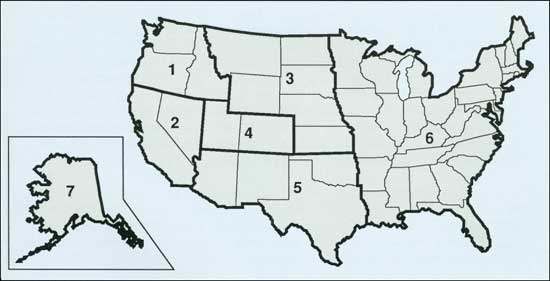
|
|
BLM regions in 1950
|
|
A DIRECTOR'S PERSPECTIVE: 1948-1953
by Marion Clawson
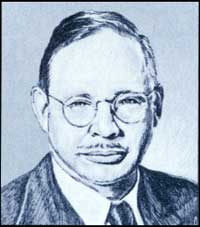
Marion Clawson (Jennifer Reese)
|
Editor's Note: Marion Clawson began his career
with the Bureau of Agricultural Economics in 1929 after graduating
from the University of Nevada, Reno, with a degree in agriculture.
He moved to BLM in January 1947 as its first Regional Administrator
in San Francisco. The following statement has been excerpted from a
chapter about Clawson's BLM experience in his latest book, From
Sagebrush to Sage—The Making of a Natural Resource Economist
(Washington, DC, Ana Publications; 1987).
The five years from March 1948 to April 1953 when
I was Director of the Bureau of Land Management (BLM) was the most
exciting, rewarding and sometimes frustrating period in my life. We
had many interesting bureaucratic adventures, from surviving drastic
cuts in our budget to obtaining BLM's first supplemental appropriations
for range and forestry programs. My main contributions to the Bureau
were to make its work more efficient and to decentralize its operations
to regional and field offices.
In December 1947, Assistant Secretary Davidson asked
me to come to Washington to discuss my becoming Associate Director of
BLM. I replied that I was unwilling to consider the job, because real
power in the Bureau lay with Tom Havell and this was a case where one
had to be the unquestioned top officer or not take on any responsibility
of top leadership.
I met with Secretary of the Interior Julius Krug and
his Under Secretary for exactly 16 minutes and was offered the position
of Director. After I accepted, Krug said that I would have to bring some
new blood into the Bureau. I agreed, but then added that it was more
important to get some old blood out, and he said, "It can be done."
So that was my charter.
About noon on 4 March 1948, I was sworn in as
Director of BLM. Within a month the House and Senate held budget
hearings. In all my professional life I have never had a more
difficult and strenuous time than the two hours or so I spent before
the appropriations subcommittee in the Senate, when our appropriation
request was under review. I was fighting to get funds restored to
the levels we had asked, to save the regional offices (which I thought
were basic), and to get permission to decentralize. I thought the
latter was extremely important for a number of reasons: decentralization
would put routine decisions nearer the land and the people they
affected, it would put the same routing decisions in the hands of new
people who were anxious to make a good showing, and it simply was
inefficient to have paper constantly flowing from the field to Washington
and back again.
In the end, we emerged as well as could be expected,
given that a struggle was underway between a Congress of one party and
a President of the other. As I recall, we got our requested funds
with a provision that was immensely helpful to me—Washington office
funds were cut and field funds were increased by the same amount. There
was no prohibition against decentralization and our regional offices
survived.
During the years I served as Director, the demand for
nearly all natural resource commodities rose and this had a substantial
impact on the public lands. Range management, soil and moisture conservation,
oil and gas leasing, and O&C forest management were major programs
during my tenure. The number and variety of applications for use of the
public lands or for records about them never ceased to amaze me. For instance,
we experienced a six-fold increase in applications for oil and gas leasing.
Our staff developed a new application form that greatly
speeded the leasing process and prevented clever applicants or agents from
tying up lands by filing slightly conflicting applications (thereby creating
nearly cost-free options to lease the land), I can still recall the glee with
which we and Assistant Secretary Davidson received outraged complaints from
applicants that we had become too efficient and it was costing them money!
Appropriations are the lifeblood of every federal agency.
Policy is as often made and/or implemented in decisions about appropriations
as it is in decisions about substantive legislation. Two incidents produced
breakthroughs in getting adequate funding for BLM.
The spread of a poisonous weed, halogeten, into
various western grazing areas enabled us, with the approval of the
Assistant Secretary, to obtain a supplemental appropriation to reseed
depleted ranges—which was desirable irrespective of halogeten. In
the end, we got something in excess of $2 million supplemental—and
this at a time when our regular appropriation was around $6 million.
With that, BLM launched a large-scale program of reseeding rangelands.
This increase went into our "base" in all the other years I remained at
BLM.
The other breakthrough concerned timber access roads in
the O&C area of Oregon. The GLO and BLM never had appropriations to
build access roads but were dependent upon timber purchasers building roads.
This lack of roads often meant a greatly reduced competition and hence a
much lower price for the timber sold.
One winter an unusually severe storm along the Oregon
coast blew down a great deal of timber. In some of these areas an
infestation of bugs was already killing live trees. These bugs could
thrive even better on blowdown timber and from that base more aggressively
infest stands of live trees. The solution was to harvest both blowdown
and intermingled standing live trees, as rapidly as possible; and for
this access roads were needed. We got a supplemental road-building appropriations
of something between $2 and $3 million; this was the beginning of BLM's
road-building in the O&C area.
In the area of communications, I utilized staff meetings
as a major management tool. I started them early on because I genuinely
wanted our divisions to know what was going on and I was convinced that an
informed Director's staff meeting the last hour of the day on every Wednesday—the
hour chosen so that people who talked too long held everyone to overtime.
A newsletter was then distributed to all employees.
At this time I formulated my second law of administration:
keep them galloping. If one can provide real leadership, develop goals
and likely means of reaching those goals, and generally run both a tight
and an innovative organization, there is much less time for petty gossiping
and dilatory actions. I did my best to keep BLM galloping. As with the
actual running of wild horses, a certain amount of whooping and hollering
was necessary.
|
|
|
Four types of field offices operated beneath the
regional level: district land offices, public survey offices, district
grazing offices, and district forestry offices. Here BLM carried out
most of its management, protection, and disposal activities. A manager
headed each office and was accountable to the regulating Regional
Administrator.
|
|
|
Clawson also gave BLM a sense of mission and purpose
by instituting a "dynamic program for resource management." Key to this
agenda was the concept of multiple use management. "Multiple use,"
according to Clawson, "is [a] system under which the same area of land
is used simultaneously for two or more purposes, often by two or more
different persons or groups." These uses could be complementary, or, as
was most often the case, competitive with one another. Clawson thought
multiple use management desirable and wanted it practiced on
BLM-administered lands.
|
|
Multiple Use
Ethic |
|
Multiple use management offered BLM managers
considerable opportunity and challenge. Land use decisions had to take
into account not only the benefits and impacts of an activity but also
their interactions with other activities. Managers now needed to know
the resource values of the public lands under their jurisdiction. This
required inventory and classification actions, so that the best and
highest priority uses of public lands, along with the most advantageous
land-tenure arrangements to promote them, could be determined.
|
|
|
Clawson emphasized land inventory and classification.
The Taylor Grazing Act directed that lands in grazing districts be
classified before disposal, and President Franklin D. Roosevelt's
general withdrawal orders of 1934 and 1935 directed the same be done
(except in Alaska) for public lands outside the grazing districts. The
Grazing Service and General Land Office had inaugurated studies, but
little of the public domain was inventoried and classified. The
classification work generally responded to individual applications for
land disposal, but case-by-case classifications
did not give BLM managers an overall picture of an
area's character and economics. This required more general
classifications of larger areas.
|
|
Land
Inventory and
Classification |

|
|
Acres classified under Taylor Grazing Act authority
|
|
|
The Missouri River Basin Project, an interagency land
inventory effort begun after World War II, helped facilitate the
agency's gathering of resource data. BLM also inaugurated smaller area
studies, usually small drainage basins where BLM had complex land and
resource use problems to resolve. The data gathered was then, as Clawson
noted, integrated into the development of long-term range plans "wherein
all tenure, protection, rehabilitation, development, and use activities
are properly and effectively balanced and implemented...initiated by
BLM, rather than in response to uncoordinated private demands for public
lands and resources."
|
|
|
Carrying out that objective required considerable
coordination. Clawson wanted to address that need through what he called
"area administration" to achieve better and cheaper management of the
public lands. Area administration meant having in a district office all
resource and technical specialists necessary for district managers to
make informed, effective, and efficient land disposal and use
decisions.
|
|
Area
Administration
Concept |
|
Clawson's "area administration" concept, which he
introduced in the summer of 1952 and his emphasis on decentralization,
land inventory and classification, along with other innovations, pushed
BLM toward becoming a viable conservation and multiple resource agency.
By the end of his tenure in 1953, range and timber lands were better
administered, wildlife and recreation resources were given added
attention, and the management of lands and minerals programs was
improved.
|
|
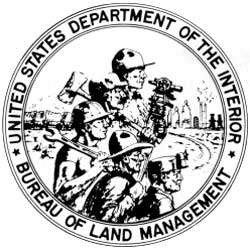
|
|
BLM emblem introduced by Marion Clawson in 1953 illustrated the
agency's development and management program
|
|
|
|
THE RANGE MANAGEMENT DILEMMA
|
|
|
Clawson knew successful implementation of his
conservation policy depended much on what BLM could accomplish on the
public range. The lands needed improvement, and this could only be
accomplished through better supervision and the institution of rangeland
plans and programs. However, these required more employees and
additional funding. Clawson knew that and attacked the problem head
on.
|
|
Range
Staffing
Problems |
|
The limited number of range management personnel
threatened to forestal any attempts at improving the program.
Nicholson's 1947 grazing proposal had stated that at least 242 personnel
would be needed for BLM to carry out its Taylor Grazing Act
responsibilities. Despite implementation of the 8-cent per AUM fee
increase that Nicholson said was necessary to cover range administration
costs, BLM in 1948 had little more than half the
personnel (123) recommended. The following year the
staff had climbed to 182, but by 1950 the number had dropped to 176.
|
|
|
BLM's grazing monitoring program, trespass
enforcement efforts, and range condition studies were hampered. Clawson
had to correct the situation if any progress was to be made. The 8-cent
an AUM fee was simply not providing sufficient funding and an increase
was obviously needed. He persuaded the National Advisory Board Council
to raise the AUM fee by 4 cents so that he could increase his range
management staff to 250 employees. In 1951, grazing district fees were
raised to 12 cents per AUM, with 2 cents of the fee still going for
construction of range improvements.
|
|
Grazing Fee
Increase |
|
The fee increase allowed BLM to hire new employees,
many of whom had college degrees in range management, and enabled the
Bureau to intensify its range management and supervision efforts.
Detection of grazing trespasses increased. Range resource inventories
and surveys of dependent ranch properties were begun in all regions to
facilitate adjudication of range use privileges. All of this helped
BLM's efforts to stop deterioration of the public range.
|
|
Range
Program
Advanced |
|
Range inventory work was particularly important.
Knowing the condition of public rangelands, BLM could take steps to
prevent further range deterioration. District managers could reduce the
number of livestock grazed, although stockraisers opposed these
reductions and usually succeeded in stopping the grazing cuts. Range
improvement and rehabilitation plans could be implemented. Fencing and
water source development permitted livestock to be distributed in a
manner that prevented overgrazing, while reseeding gave new life to
depleted range.
|
|
|
BLM financed the construction of range improvements
with the 2 cents received from the AUM fee assessed ranchers and from
appropriations under the National Soil Conservation Act for soil erosion
control projects. Ranchers and grazing advisory boards also contributed
money, materials, and labor. BLM, however, could still do little more
than maintain existing projects. Director Clawson in his 1951 report
Rebuilding the Federal Range asked Congress for more funds, noting
that more than 38,000 stock-watering improvements and 68,000 miles of
fence, along with other items, needed to be constructed. However,
Congress made no effort to provide the additional funding Clawson
wanted.
|
|
Range
Improvement
Needs |
|
Congress responded more favorably to BLM efforts to
rehabilitate the range. The Director in his 1951 report on public range
conditions noted that 22 million acres of public land needed
revegetation. He was again unable to get direct funding for this effort,
but he was indirectly successful by getting Congress to enact the
Halogeton Control Act of 1952.
|
|
|
Halogeton is a weed poisonous to livestock that
establishes itself on range in poor condition. The weed, however, can be
controlled through maintenance and redevelopment of healthy ranges. The
Halogeton Control Act sought to arrest Halogeton's rapid spread across
the West and, consequently, provided BLM with badly needed range
restoration funds.
|
|
Range
Depletion and
the Halogeton
Problem |
|
THE RANGE ADVISORY BOARD SYSTEM
A. D. Brownfield, Chairman, National Advisory Board Council
From Our Public Lands, October 1951
The range advisory boards of the Bureau of Land
Management have proven in 15 or 16 years operation valuable adjuncts
in the administration of the Taylor Grazing Act. The system was inaugurated
by the first Director of Grazing with success...so much so, that Congress
soon took notice of the good results, and by amendment to the act, made
the provision for advisory boards permanent.
The Plan for selecting these advisors is in
keeping with our traditional American way of choosing Government
representatives—that is, by election—and thus had support
from the beginning. At the outset, and in compliance with the law,
in order to determine who would be allowed to vote, districts were
set up in each State, and each livestock producer therein was allowed
a vote for the advisors of his own districts.
Instituting the system by popular election allayed
suspicion and facilitated cooperation by those users of the public
range (or public domain) who had never known regulation, or considered
any law necessary for their protection and guidance in the proper use
of their fee lands and leased lands. It brought into the various local
offices for assistance to the Secretary representative men from "the
wide open spaces" better qualified to advise and recommend on proper
division and use of the range, and furnish information on its past use
by contending applicants, and the approximate carrying capacities of
the range. It would have taken years of research and untold quantities
of taxpayers' money to have gathered the information that was quickly
furnished by these professionals of the range. Very little dissatisfaction
has ever been registered against the system, proof of which lies in the
fact that in all of the 10 Western States in which there are grazing
districts, citizens of no one of these States have petitioned for a change
to something different.
The method of administrative procedure was extremely
simple and applicable to range use. All the range was first rated as
to proper number of stock to be grazed, and seasons of use. Each applicant
for a permit was required to furnish accurate information as to his owned
or controlled land and water; he also had to state the numbers and class
of livestock grazed on the public domain prior to the passage of the Taylor
Act. Where reductions in numbers were found necessary to protect the range
such reductions were on a prorated basis in community allotments. In
individual allotments, reduction was made to fit the carrying capacity.
In the absence of basic data on range surveys, classification,
topography, etc., these advisory board members furnished timely information
until such work cold be started and completed (Much of which has not as yet
been finished). Moreover, they serve as popular unpaid policemen for
regulating grazing, trespassing, and other abuses. They also give
information on necessary range improvement facilities—such as
fences, wells, dams, reservoirs, stock trails, driveways, cooperative
plans with State agencies, land exchanges, soil and moisture expenditures,
and many other programs.
Decentralized government has made and kept America
strong. There is no substitute for it. The same has proven true for
good land management. Personal contact with the users of the range
through the advisory board system has made "home rule" on the range work.
|
|
|
FORESTRY PROGRAM DEVELOPMENT
|
|
|
The Bureau's forestry program went through
significant changes during the Clawson years. BLM introduced a new sales
policy for the revested Oregon and California land grant lands in western
Oregon that increased competition and laid the foundation for better
management. It also inaugurated the management of public domain
timberlands.
BLM found management of the O&C revested lands in
western Oregon particularly challenging. When Marion Clawson became
Director, the regional administrator in Portland, Walter Horning, who
was formerly Chief of the General Land Office's O&C Administration,
remained committed to a policy of achieving sustained-yield management
for both O&C forests and private timberlands through cooperative
agreements. The plan allowed private landowners to purchase stumpage
rights to the intermixed O&C forest lands at appraised value and
under 100-year cooperative agreements if they consented to follow
sustained yield requirements developed by BLM.
|
|
|
The 100-year cooperative agreements plan, however,
brought strong criticism. Many interests, particularly timber operators
who did not own lands within the O&C area, felt the plan would give
cooperators a monopoly. Revenues from O&C timber sales would
decline, it was argued, and landowners would have no incentive to permit
multiple use or implement good forestry practices. The protest, led by
the Association of O&C counties, forced BLM to abandon Horning's
plan in 1948.
|
|
O&C Policy
Problems |
|
Director Clawson, as part of his 1948 reorganization
effort, replaced Walter Horning with Dan Goldy. Goldy was an economist
who had worked in the Interior Department on O&C matters. He felt
that the timber operators within the O&C area had the monopoly.
Goldy, fervently believing in competition and equal opportunity,
developed a timber policy that would end the monopolistic and poor
timber practices encouraged on adjoining private lands.
|
|
|
First, potential buyers had to be assured of access
to BLM's O&C tracts. Most access roads within the area were privately built and controlled.
The Bureau instituted a policy requiring the builders to
give BLM and its timber purchasers reciprocal use of
rights-of-way across adjacent private lands.
BLM also sought to end its dependence on private
access roads through construction of its own road system. This would not
only give O&C timber purchasers access rights, but would also lead
to better timber conservation practices because BLM could then build
into areas of overripe or damaged timber in need of harvesting. The
Bureau began building its road system in 1950. The following year, when
extensive fires and wind storms damaged and downed more than 700 million
board feet of timber, Director Clawson was able to get additional
appropriations from Congress to build more roads into the affected
areas.
|
|
New O&C
Policies |
|
Policy further called for timber companies to submit
suggestions as to what lands should be offered for sale during the
following year. In consultation with the district O&C advisory boards, BLM then
developed a sales plan based on these suggestions and informed
prospective buyers months before auction.
The first competitive sales under the new policy came in 1950. The
volume of sales jumped from 265 million board feet to nearly 396
million. During the following year, the volume sold remained the same as
in 1950, but the price bid went from $4.8 million to $8.7 million.
|
|
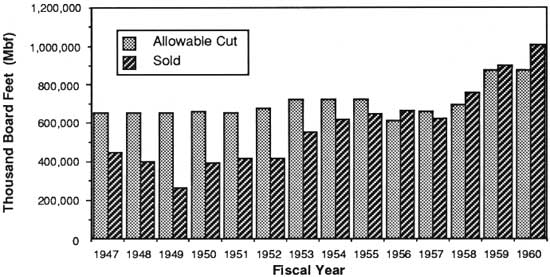
|
|
O&C timber sales 1947-1960
|
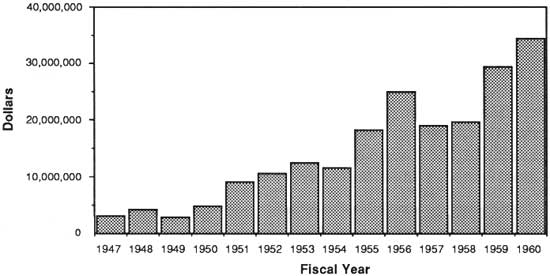
|
|
O&C timber sale values
|
|
|
Other changes instituted during Clawson's tenure
further enhanced BLM administration of O&C lands. The forestry staff
in Oregon gave new emphasis to timber inventories. Inventories were
essential to determine the amount of timber that could be cut. BLM began
new inventories that not only calculated the volume of available timber
but provided information on the age, quality, size, and the location of
stands from roads and processors. The new data was used to develop
management plans and helped BLM better determine how much timber could
be sold each year on a sustained yield basis.
|
|
|
The most significant change, however, involved the
O&C advisory boards. In 1948, the Department of the Interior and BLM
reorganized the boards to promote broader public representation. Members
now represented not only the timber industry, State of Oregon, and
counties, but also labor, mining, agriculture, recreation, wildlife, and
conservation groups. This action more closely reflected the multiple use
character of O&C lands and gave BLM a broader management
perspective.
|
|
O&C
Advisory
Boards |
|
BLM also developed a forest policy for public lands
outside the O&C area. There were an estimated 3 million acres of
commercial forest lands and 25 million acres of woodland, exclusive of
Alaska, on public lands. Prior to 1947, BLM had no authority to manage
these lands. It could only dispose of the lands or remove dead-and-down
timber to reduce fire danger. The Materials Act of 1947 changed this,
permitting BLM to sell timber from public lands.
|
|
|
BLM recognized public domain timber would not equal
the volume or value of O&C timber, but because many of the stands
were important to local economies, they too needed management. BLM,
however, did not have foresters to oversee or administer these lands
until 1949, when an increase in funding allowed BLM to place foresters
in each regional office and a few grazing districts. Inventories
subsequently began and sustained yield cutting plans were developed.
|
|
Public
Domain
Timber
Resources |
|
BLM also pushed forestry efforts in Alaska. The
Territory had 125 million acres of public timberland. Stumpage from
Alaska's public lands could be sold through the Act of
May 14, 1898. The General Land Office's local land officers had handled timber
sales until the responsibility was transferred in 1946 to the Alaskan
Fire Control Service (AFCS). With the creation of the Bureau of Land
Management, the AFCS became Alaska's Division of Forestry. Like the
AFCS, it provided fire protection, controlled forest use, supervised
timber sales, set up sustained yield forestry units, and encouraged new
wood-using industries. The new Division, however, put more emphasis on
timber inventory work.
|
|
Forestry in
Alaska |
|
FIRE SUPPRESSION
|
|
|
Fire prevention and suppression was an integral part of BLM's timber and
range management programs. When Clawson became Director, the Bureau's
fire program had changed little from that of the General Land Office and
the Grazing Service.
|
|
|
Fire suppression efforts under the GLO and Grazing Service largely
depended on cooperative agreements with federal and state
agencies and local protection organizations. Insufficient funds
forced BLM to continue this practice on the nearly 6 million acres of forest
land in California, Idaho, Montana, Minnesota, Arkansas, Washington, and Oregon.
|
|
Fire
Protection
Contracted |
|
In other areas, BLM used its grazing and forestry district personnel
to develop a fire suppression organization. District fire
crews were established and could be supplemented, during large fires, with
personnel from other districts.
|
|
BLM Fire
Program |
|
To assist district crews, BLM in 1951 began
purchasing 4-wheel-drive high-pressure pumper trucks. The vehicles,
though few in number, quickly proved their value as two-person crews
showed the pumpers' effectiveness in suppressing range fires. That same
year, BLM also began installing high-frequency radio networks in an
effort to decrease response time to fires and more effectively
coordinate firefighting efforts.
|
|
|
In Alaska, the Bureau did what it could to maintain
the small, but well organized Alaskan Fire Control Service it had
inherited from the General Land Office. Firefighters in Alaska found
themselves confronted with an increasing fire problem as settlement,
tourism, and military activity increased after World War II. Fire
control efforts, although hampered by Alaska's immense size and lack of
access were aided by cooperative agreements with other federal
departments and agencies. The U.S. Weather Bureau supplied forecasts and
relayed emergencies, while military and Civil Aeronautics Authority
aircraft aided in fire detection and the transportation of crews and
equipment.
|
|
Fire
Protection in
Alaska |
|
WILDLIFE
|
|
|
The fire program's primary purpose was to protect
forest and rangelands from damage and waste, but the program also
benefited wildlife habitat. And the Taylor Grazing Act addressed the
importance of wildlife on the public lands by opening grazing districts
to hunting and fishing and allowing the Secretary of the Interior to
work with state wildlife agencies in managing wildlife habitat.
|
|
|
The Grazing Service took wildlife habitat into
consideration and permitted wildlife interests to play an active role in
administering the grazing districts in New Mexico and Oregon. New Mexico
stockraisers included one wildlife representative on their advisory
boards. By 1939, all district boards had wildlife representatives. The
Grazing Service also worked closely with state and federal wildlife
officials and hunting and fishing groups.
|
|
Grazing
Service Policy |
|
BLM continued the Grazing Service policy toward
wildlife. Wildlife habitat management was an important part of BLM's
range program. District managers worked closely with their advisory
board's wildlife representative and state officials in managing wildlife
on public lands. Some states helped the Bureau in rangeland reseeding
efforts, which increased forage for wildlife as well as for
livestock.
|
|
Early BLM
Policy |
|
RECREATION
|
|
|
Recreation was another important resource on public lands. The
Recreation Act of 1926 provided for the transfer and lease of
recreational lands to state, territorial, and local governments if they
were not needed by the federal government.
|
|
Recreation
Act of 1926 |
|
TALES OF EARLY BLM FORESTRY IN ALASKA
by Edwin Zaidlicz
Former Montana State Director
It was the bitterly cold winter of 1949 when I joined
BLM by replacing the first professional forester in the northern half of
Alaska at Fairbanks. The forestry program was truly embryonic and our
first responsibility had to do with containing tundra fires and as need
and time warranted, we processed fire wood permits.

Edwin "Moose" Zaidlicz in 1951. (Edwin Zaidlicz)
The Homestead Act was alive and well with our
management authority and objective based on the land laws that
encouraged land disposal. For a forester trained under the principle of
long-term forest management under sustained uniform yield, a
philosophical stress quickly developed. BLM appeared unready to accept
long-term management of public land for any purpose.
I soon found myself at odds with the man in the fine
office across the street—the Fairbanks Land Office manager. Until
I, as the "cheechako stump jumper" arrived, his role as a "Fed" was
time-honored and respected.
Then, during the next spring, Bob Robinson, our head
forester in Anchorage, budgeted enough to hire three more foresters for
Fairbanks.
Our "strange breed of cats" group had few
regulations, no manuals other than those for fire and fiscal management
and almost no direct supervision. Communications with Anchorage involved
very slow mail, emergency air flights or our "Mukluk telegraph," a
system of in-house war surplus radios.
Quickly we learned to use our own discretion rather
than risk an undesirable and tardy decision from the south. We enjoyed a
commonality of purpose, unlimited energy and enthusiasm, and an
unavoidable need for creativity and innovation. State-of-the-art
technical props included the radio, a Cessna 180 plane on floats or
skis, a Polaroid Land camera and a handful of college textbooks.
Undaunted, we "came out of the chute" by initiating
1) The first timber inventory of interior Alaska by
sampling stands along the Yukon, Porcupine, Tanana and Chena rivers.
Even then I squirmed at our audacity and possible sampling error. The
Cessna and an outboard river boat served for transportation. Our aerial
photography consisted of shots with hand-held cameras;
2) A small tree nursery and a post-treatment
experiment. Dr. Harold Lutz, a forest soils authority from Yale and Dr.
Ray Taylor, Chief of the USFS Alaskan Research station visited us. We
proudly demonstrated our Rube Goldberg watering system. Dr.
Taylor, a gentle and kindly man, expressed guarded admiration for our
initiative and novel operation. Dr. Lutz, a crusty pragmatist, made
a more objective observation— "Your Herculean efforts will perhaps
retard the cause of scientific forestry 100 years;"
3) Having the full support of the Air Force and the
use of their vast depot of heavy equipment to take charge of any
threatening tundra fires, we did some dramatic improvisation. We
dispersed eight D8 caterpillar tractors in two units under a "USFS one
lick fire line approach." A serious fire was quickly controlled. We were
then visited by Mr. Gustafson, Fire Chief of USFS in D.C. and Mr.
Blackerby of the USFS Regional Office to study our "perma-frost fire
control." Gustafson, clearly impressed, observed that our "fire trails
could unquestionably be seen from the moon;"
4) In an effort to improve the stagnant economy of
our District, we got involved with a troubled Swedish homesteader to
gather and process birch tree sap—much as is done on maple trees.
While the syrup proved quite tasty, our new industry never displaced
firewood cutting or muskrat trapping;
5) During the winter of '50-'51, Bob Robinson
initiated the first formal timber inventory to undergird a possible
timber operation in Alaska's southern district on Windy Bay. Three
foresters from Anchorage and I were flown into the tract by a WWII
"Goose" piloted by Bob McCormick. We had a large double canvas tent, our
personal gear, grub for 30 days and explicit instructions from Bob R.
For emergency use we had a special surplus-parts radio. About the time
McCormick waggled his wings in his departing flyover, we confirmed the
radio didn't work.
After 5 weeks, we completed our field sampling and
were returned to civilization. Living in continual snowstorms and
howling winds with three unwashed companions in a tent that served for
cooking and living was an unforgettable experience and gave me a new
meaning for the term "cabin fever." I did learn that it is possible to
respect and admire another sharing the same traumatic circumstance. It
was there that I made a life-long friend of the legendary Jim Scott.
Perhaps the highlight of my forestry career in Alaska
occurred in the fall of 1951 when I almost succeeded in putting my
admirer, the Fairbanks Land Office Manager, in jail for a fire and game
violation. The word of this "forestry action" quickly spread throughout
Alaska and BLM. The manager was arraigned, fined and lost his game
license. Shortly thereafter, he was actually promoted to a more
desirable post in the States and I got the opportunity to transfer to
the O & C in Roseburg, Oregon.
My vivid recollection of those adventurous days of
early Alaskan forestry highlight impressions of vast untapped resources,
immense distances, unparalleled natural beauty and the troubling
insignificance of man's puny efforts to impact or manage any of the
resources, especially timber and wildlife. Even our natural disasters
were brutally intimidating; our 1951 Porcupine River fire burned 2
million acres in what seemed like a couple of days. To simply map the
burn area took 5 hours of flight in a Cessna 180. We had to carry
5-gallon tins of fuel to gas up on shallow duck lakes.
Clearly the quality of humility in a neophyte
forester is desirable and Mother Nature provides
a dramatic setting in Alaska for developing it.
|
|
|
BLM's lack of legislative authority to provide recreational
opportunities did not dampen the agency's interest or
efforts in recreation. Some BLM resource programs benefited recreationists
indirectly—such as wildlife habitat management and access road
construction. The Bureau's land classification program identified many potential
sites for acquisition under the Recreation Act of 1926. In some areas,
district personnel built
facilities, such as camp and picnic grounds, even though they did not
have the authority to do so.
|
|
Lack of
General
Recreation
Development
Authority |
|
The increasing public demand for recreational opportunities after
World War II was furthered by the Small Tract Act of 1938. This law,
as amended, provided for the sale or lease of tracts not
exceeding 5 acres that were determined to be chiefly valuable for recreational,
residential, business, or community site purposes. In 1949 there were nearly
7,500 Small Tract Act leases. Clawson commented that the Small Tract Act had
become the law preferred by those seeking a home on the public domain.
He was right. By 1952 the number of Small Tract Act leases had climbed
to more than 25,000, and nearly 300 parcels had been sold for
patent.
|
|
Small Tract
Act |
|
LAND HUNGER IN THE EARLY 1950s
|
|
|
The Small Tract Act was indicative of public land
activity after World War II. Homestead, Desert Land, and other types of
entries increased sharply. Interest was particularly high among
veterans, who received preference in making entries, but BLM had to deny
many of the applications because the lands entered were not suited to
agricultural development. As Director Clawson stressed, public land
policy since the Taylor Grazing Act of 1934 looked to "the management
and protection—and selective, rather than summary disposal—of
the approximately 778 million acres of public domain and their resources
in [the] continental United States and Alaska." Statements such as this
did not dissuade potential settlers; the lure of the public lands was
too strong.
|
|
Post-World
War II Boom |
|
Alaska experienced much of the boom. Thousands of
military and civilian personnel sent to Alaska during World War II saw
first-hand the opportunities Alaska had to offer, and many stayed to
take advantage of the situation. Hundreds of others came after the war
by way of the Alaska Highway, drawn by stories of the Territory's
riches.
|
|
Alaska: Land
of Promise |
|
Many who came to Alaska used the Homestead Law to
acquire land; from 1946 to 1953 more than 3,300 such entries were made.
Competing with the Homestead Law was the Small Tract Act. Extended to
the Territory in 1945, Small Tract Act sites were used to acquire lands
for homesites, weekend cabins, and businesses around Anchorage and
Fairbanks. By 1953, 600 sites had been sold and nearly 2,500 tracts were
under lease.
Settlement and development of Alaska, however, was
retarded by the lack of survey. Surveys were needed to adjudicate
applications for use and disposal of public lands, but at that time only
2.5 million acres, or 1 percent of the Territory, had been surveyed
under the rectangular system. BLM made surveys a high priority, but appropriations
during Clawson's tenure permitted little more than 100,000 acres to be
surveyed.
|
|
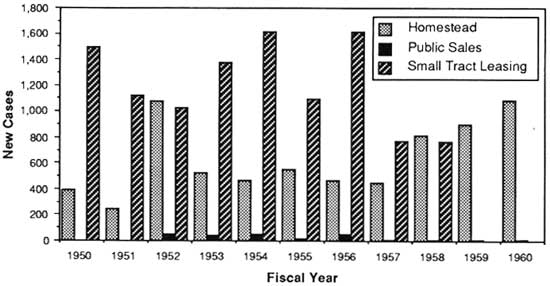
|
|
New land case actions in Alaska 1950-1960
|
|
|
Land classification in Alaska was another important
issue. BLM wanted orderly settlement and development for the Territory.
The Bureau, however, had no general land classification mandate in
Alaska, and so, the agency made do with the few authorities it did
have.
Classifications required under the Small Tract Act
were used to identify public lands values and control development around
Anchorage, Fairbanks, and other Alaskan towns. The Alaska Public Sales
Act of 1949 was also used to advantage. This law provided for the
auction of 160-acre parcels of surveyed and unsurveyed lands to
individuals and other interests who met certain criteria. Successful
bidders were required to file a satisfactory plan of development for the
tract and complete their project within 3 years or forfeit both the land
and the money bid. In 1952, the Bureau, in cooperation with the Soil
Conservation Service, launched a program of planned homestead
development by identifying suitable lands and marking out farm units for
prospective settlers.
|
|
|
Land applications were also increasing in the "Lower
48." The Bureau's decentralization of land case adjudication
to the regional offices helped speed processing, but the crush of
applications was overwhelming.
|
|
Lower 48
Lands
Situation |
|
In response to the increasing backlog, BLM wrote new
regulations to streamline the adjudication of cases. The Bureau also
began developing a new land record system. Through a microfilming
process, certain land records, such as patents, could be more easily
used and more effectively preserved. BLM also created a Division of
Lands from its adjudication and land planning divisions in 1951 in an
effort to more effectively administer the lands program.
Director Clawson called for a congressional review of
public land laws. He pointed out, like the General Land Office had
before him, that many of the laws under which the Bureau operated were "to a
large degree outmoded and incoherent" and in need of revision. However, Congress felt that the
policies did not need substantial revision.
|
|
|
MINERALS
|
|
|
Development of federal minerals became increasingly
important after World War II. Truman's Reorganization Plan No. 3 gave the
Secretary of the Interior responsibility for all mineral activity on
federal lands. The Bureau continued General Land Office functions by issuing leases
and administering mining claims on the public lands. It also began overseeing
the leasing of mineral estates acquired by the federal government with the passage
of the Acquired Minerals Leasing Act in 1947.
|
|
Mineral
Leasing
Responsibility |
|
Oil and gas activity best reflected the new surge of
mineral activity on the public lands. Petroleum companies had increased
their lease and exploration for oil and gas during World War II and
continued this activity after 1945. A boom in activity,
however, did not come until 1950. That year
alone saw 16,000 noncompetitive leases
filed compared to the 4,000-a-year average during World War II. In 1951,
BLM created a Division of Minerals at Washington headquarters to better
handle the resulting workload. This action came at the right time. In
that same year, an unprecedented boom in petroleum leasing came with the
discovery of oil in the Williston Basin in North Dakota and Montana. The
resulting "black gold fever" caused the number of new oil and gas lease
applications to jump to nearly 32,000 in fiscal year 1952.
|
|
Oil & Gas
Boom |
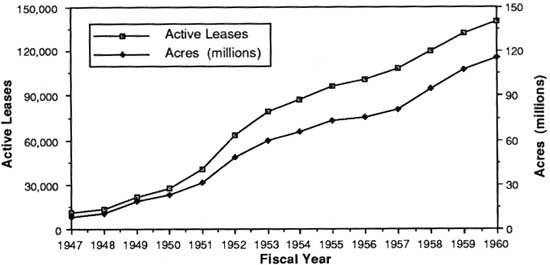
|
|
Active Oil & Gas leases for public domain lands 1947-1960
|
|
|
Increased oil and gas leasing created many headaches
for BLM, but the worst was the age-old problem of speculation and fraud.
Through newspaper and magazine advertisements, oil and gas brokers
appealed to the desire of people to get-rich-quick by offering to file
40-acre federal leases for them. "The practice," complained Director
Clawson, "not only swamped land offices with thousands of applications,
but retarded the orderly exploration for oil and gas." The Justice
Department called the practices of the oil and gas brokers unethical but did not have
sufficient evidence of misrepresentation to prosecute the filing firms.
BLM did, however, try to end the problem by revising its regulations to
prohibit the issuance of leases for less than 640 acres in areas outside
producing units.
|
|
Speculation
and Fraud |
|
THE CLAWSON LEGACY
|
|
|
By 1953, Marion Clawson had transformed the Bureau of
Land Management into a multiple resource agency. As Director, he had
been able to institute reorganization and policy changes with little
controversy. The Bureau under Clawson also strengthened many programs
through better funding and the hiring of additional people. Clawson
established a firm foundation upon which the Bureau's resource programs
could build and the agency's developing multiple use ethic could grow.
It was a commendable job, but his land management philosophy differed
from that of the new Eisenhower Administration; he was forced to leave
the Bureau of Land Management in 1953.
|
|
Clawson
Accomplishments |
|
THE EISENHOWER ADMINISTRATION AND "PARTNERSHIP IN CONSERVATION"
|
|
|
The Presidential election of 1952 swept Dwight
Eisenhower and the Republican Party into the executive branch after a
20-year hiatus. Republicans were not hesitant in using their victory to
reshape public land policy. They did not intend a wholesale dismantling
of the conservation policies inaugurated by the Democrats, but they did
seek to loosen the restrictions they felt Democratic conservation policy
had placed in the way of private development of public lands and
resources.
|
|
Republicans
Gain the
White House |
|
"Partnership" was the key word of the Eisenhower
Administration's public lands policy. "The best national resources
program for America," stated Eisenhower in his first State of the Union
Address, "will not result from exclusive dependence on federal
bureaucracy. It will involve a partnership of the states and local
communities, private citizens and the federal government, all working
together." Eisenhower selected Douglas McKay, Governor of Oregon, as his
Secretary of the Interior. McKay was more blunt in expressing the new
Administration's public lands policy. After taking his new job, he
declared, "we're here in the saddle as an administration representing
business and industry." To accomplish this, McKay emphasized reduced
bureaucracy, greater states' rights, and a freer hand for private
interests. The new Secretary wanted agency chiefs who adhered to this
philosophy and in McKay's view, Marion Clawson was not such a man.
|
|
New
Conservation
Thrust |
|
Clawson was viewed by the incoming Republicans as an
advocate of central planning by government and as having the opinion
that government could manage resources better than private interests.
This led some Republicans to suspect Clawson of being a socialist.
Clawson had to go; Secretary McKay asked the BLM Director to resign. Clawson refused,
citing his civil service status required a reason for his removal. McKay
found one: insubordination.
|
|
Clawson
Leaves |
|
DIRECTOR EDWARD WOOZLEY: A CHANGE IN DIRECTION
|
|
|
Marion Clawson was replaced in May 1953 by Edward
Woozley. Woozley, the commissioner for state lands in Idaho, supported
the Eisenhower Administration's States' rights platform and pro-business
and industry stance. The Idahoan was also described by supporters as
"capable, imaginative, and resolute." This was a man more to McKay's
liking; however, Woozley did not meet the civil service requirements for
Director and so had to serve as Bureau Administrator for the first year
of his nearly 8-year tenure.
|
|
Director
Edward
Woozley |
|
Among Woozley's first actions was the reorganization
of BLM. He and Secretary McKay felt the Bureau was too centralized, even
after Clawson's restructuring. A committee comprising three Departmental
employees and three members of the public agreed with the assessment.
They concluded that there remained "too great a concentration of
operations in the Washington and regional offices."
|
|
BLM
Reorganized |
|
Acting on the committee's recommendations, Washington
headquarters was restricted to providing major policy direction to the
field organization. The regional offices were reorganized into four Area
Offices—not to be confused with Marion Clawson's "area
administration" initiative—with Area Administrators having general
administrative and supervisory responsibility over the activities within
their jurisdictions.
Most of the former regional office responsibilities
went to a new organizational level called State Offices (except Alaska).
These became the highest level of operations and implementation in the
field, taking on adjudicative, land classification, and other land and
resource functions. The State Supervisors in these offices dealt with
state officials within their jurisdiction and developed long-range
resource management and disposal programs. Along with their resource
staffs, the State Supervisors also provided advice and technical
direction to the District Offices.
District Offices continued as the lowest
organizational level. The District Land Offices maintained land status
records and took applications for public lands and minerals. District
Grazing and Forestry Offices handled applications for range use and
timber cutting as well as other actions.
Woozley, like Clawson before him, felt this
decentralization of responsibilities and functions would bring public
land management and decisionmaking closer to the user level, thus
increasing efficiency and lowering administrative costs. The
reorganization was implemented in 1954, and BLM's structure changed very
little during the remainder of Woozley's tenure.
|
|
|
Woozley saw BLM as a business manager and felt that
"the full worth of the valuable resources on the public lands may
be realized with a minimum expense to the taxpayer and that through
careful cooperation with private enterprise, these lands can produce the
products on which local, state, and national economy depend." This
outlook would characterize the Woozley years.
|
|
BLM is a
Business |
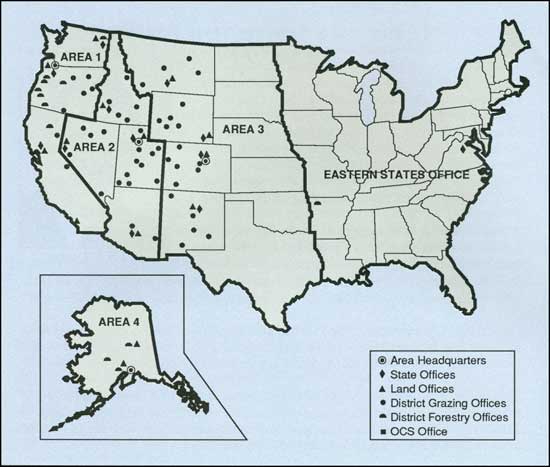
|
|
BLM reorganization of 1954
|
|
|
RANGE MANAGEMENT ISSUES
|
|
|
When Woozley became Administrator, the range
management program again became a center of controversy. The Republican
Party Platform for the 1952 Presidential election had called for
legislation that would better define the rights of public land users and
protect those rights against administrative interference. In line with
that pronouncement, Republican Congressman Wesley D'Ewart introduced
legislation aimed at making the privilege of grazing on public lands a
legal right by guaranteeing grazing use and providing for judicial
review of administrative decisions.
|
|
New
Range Use
Controversies |
|
Conservationists immediately attacked the D'Ewart
bill. Montana Senator James Murray called it "another monumental
giveaway" measure. The Department of the Interior could not even support
the bill, and the legislation, as well as an amended version in 1954,
was defeated.
|
|
|
A DIRECTOR'S PERSPECTIVE:
1953-1961
by Edward Woozley
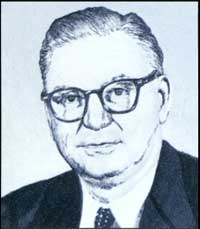
Edward Woozley (Jennifer Reese)
|
Editor's Note: Edward Woozley came to BLM with
the Eisenhower Administration in 1953 and helped shape
Secretary of the Interior Douglas McKay's "Partnership in Conservation"
policy. Woozley was suited to the challenge. He had been Idaho Land
Commissioner and appraised land for the Idaho State Land Board and the
Production Credit Corporation. In July 1960, Director Woozley wrote of
the BLM's accomplishments in the years since his appointment.
We in the Bureau have been giving much thought to the future in
recent months. Our look ahead certainly told us that there still remains
much to be done in managing the Nation's resources. But the enormity of
the job ahead shouldn't cause us to lose sight of some of the
achievements we have made in the past. The last seven
years have been impressive.
For FY 1953 Congress appropriated slightly more than
$14 million. For the year just ending the figure will be closer to $34
million, and the figure will probably be higher next year, if the
various receipts from which we get a share, come up to expectations.
Receipts too, give an idea of the growth that has
been made. In 1953, the cumulative total of receipts by BLM and its
predecessors over some 140 years reached the landmark figure of $1
billion. In the last seven years, that figure has been reached for the
second time. In FY 1960 alone our receipts will be approximately $375
million.
Of course our growth cannot be measured in terms of
money alone. In 1953, a new record was set when 626 million board feet
of timber was cut on O & C lands. For this past year the cut will be
approximately a billion board feet. In 1953, we closed about 60,000
cases in our lands and minerals adjudication processes. When the final
figures are totaled for 1960, the number of cases closed will be close
to 220,000. Our classification and investigation program in the same
period will show a gain of 35 percent over the 23,306 cases closed in
1953. In our cadastral survey program the total number of acres surveyed
each year is now approaching 2,000,000, an increase of about 16 percent
over 1953. But the big jump comes in original surveys, where our present
program calls for surveying more than twice the acreage surveyed in
1953.
Statistics tell only part of our story. The Bureau,
for example, has supported and helped prepare innumerable pieces of
legislation advancing the cause of conservation and resource management.
The 1954 amendment to the Recreation and Public Purposes Act has
provided a tool of increasing importance to the Bureau in meeting the
Nation's increasing demand for resources devoted to recreation and
leisure time activity. The Outer Continental Shelf Act, passed in August
1953, already has returned to the U. S. Treasury more than $434 million,
with an additional $300 million held in escrow pending final
determination of its distribution by the Supreme Court.
Another major legislative milestone was the passage
in 1955 of Public Law 167, the most important piece of minerals legislation since the
1920 Mineral Leasing Act. Multiple use of surface resources, and the
elimination of many serious conflicts between surface management and
mining operations, became achievable realities as a result of the Bureau
program developed under this law.
While legislation is behind some of the changes in
the Bureau's activity, major importance must be attached to those
non-legislative changes which also have been instituted. The concept of
a unified and coordinated program of resource management based on state
boundaries, was a major purpose of our 1954 reorganization and the
increased effectiveness of operations within the various states has
proven the value of that move.
Long range conservation programs tell a significant
story of Bureau progress. The Bureau's reforestation program is a case
in point. A comprehensive inventory in 1957 showed that more than
150,000 acres of western Oregon forest lands needed artificial
reforesting. In that year the Bureau began a greatly accelerated forest
land rehabilitation program and to date 75,000 acres have been planted.
This program will place cutover and burned lands in production 5 to 20
years sooner than nature's normal processes.
Great strides have been made also in a variety of
management activities. The deterioration of the public lands records
through age and use threatened to make these vital records useless to
future generations. Early recognition of this problem and the
development of our long range records improvement project has enabled us
to take an enormous step forward, in not only preserving them but
putting them in a form that adds greatly to the clarity and ease of
use.
Surveys of our land offices, our forestry programs,
and the operation of our grazing districts have led to significant
changes in the organization and management of our activities, thereby
increasing their efficiency, and enhancing their ability to serve the
public.
Speeded operations through automation have become
increasingly significant in recent years. We now acquire forest
inventory data through automatic data processing in Oregon; bills are
automatically prepared from punched paper tape in Cheyenne; a robot
typing machine prepares answers to correspondence in Los Angeles; and
photocopy and other reproducing equipment enables us to prepare almost
instantaneously, copies of records and maps, from originals or from
microfilm.
Field techniques likewise have benefited from the
adoption of new tools and equipment. The Bureau pioneered the program of
fighting major fires in Alaska through airborne borate drops. Our
engineering survey parties have achieved outstanding results through the
use of helicopters, photogrammetry, and tellurometric equipment, the
first truly major changes in surveying techniques in more than a
century.
In all, these have been eventful years. Progress
hasn't always been as fast as we would like, but when we look back to
where we have been, it is clear that we have made great strides. The
road ahead looks more promising today than ever before. When we recall
the idea that "What's past is prologue," it can be said that the future
looks very bright.
|
|
|
Woozley was sensitive to the debate on Capitol Hill
and wanted to cool the controversy. Some ranchers complained that nearly
half of them operated on public lands with only year-to-year leases;
they wanted more secure tenures. Woozley addressed the problem by
declaring it the Bureau's policy to give more than 90 percent of its
range users 10-year grazing leases as fast as the necessary reappraisals
of user leases would permit.
|
|
|
Woozley, therefore, made range adjudication the range
management program's highest priority. BLM's range staff stepped up work
on range condition inventories and the surveying of private ranch
properties to determine carrying capacities and grazing use privileges.
The work was slow because of the limited staff, but the Bureau moved
ahead and made great strides in adjudicating range privileges.
|
|
Range
Adjudication
Efforts |
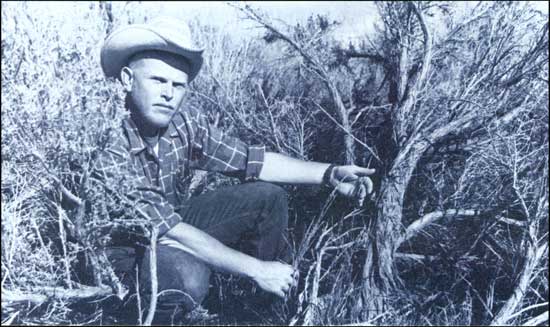
|
|
Range inventory work near Dillon, Montana
|
|
|
The reappraisals led to controversy. BLM grazing
district managers, with "hard and cold facts" in hand, often reduced
range use to levels more compatible with the new carrying capacity
determinations. Stockraisers did not like the cuts and resisted BLM's
efforts to impose them. BLM, however, did what it could to work out the
disagreements and was usually successful in reducing range use where it
was needed.
|
|
|
Face-to-face dealings were important in these
situations, but grazing district managers seldom had time to meet with
each rancher individually. To overcome this problem in Idaho, State
Supervisor J. Russell Penny began in 1957 to divide his grazing
district offices into subunits. Each subunit was assigned to a "Division Manager" who was
responsible for public relations and range management within his
division. This forerunner to today's area manager concept was an unofficial
innovation, but it worked well and helped ease the controversies that
arose between BLM and ranchers.
|
|
Idaho
Innovation |
|
BLM's range adjudication program was also aided by
additional funding. The 12-cent AUM fee secured by Marion Clawson in
1951 was not sufficient to fund the range management program. Woozley
felt that tying grazing fees to the cost of administration handicapped
BLM management efforts. He therefore advocated that the range management
program be funded largely from appropriations. However, he still wanted
ranchers to pay a portion of this cost and felt it fair to tie the fee
charged them to the price they received for their livestock at
market.
|
|
Grazing Fees
Restructured |
Grazing Fees 1936-1960
Taylor Grazing Act Lands |
| Years | Animal Unit Month Fee ($) |
| 1936-1946 | .05 |
| 1947-1950 | .08 |
| 1951-1954 | .12 |
| 1955-1957 | .15 |
| 1958 | .19 |
| 1959-1960 | .22 |
He approached the National Advisory Board Council
with the idea in early 1954. The group, after some months, agreed to the
new grazing formula. The new fee would vary with the average price paid
per pound for cattle and sheep in the eleven western states. Twenty-five
percent of the fee was to go for range improvements.
The fee for 1955, based on 1954 livestock prices,
called for an increase from 12 cents to 18 cents per AUM. Director
Woozley felt the 50 percent fee hike was too drastic and had the
Secretary of the Interior agree to arbitrarily set the fee at 15 cents
until 1957. Drought conditions in many parts of the West in 1957 delayed
institution of the new grazing formula for another year. The fee for
1958, based on 1957 market prices, was 19 cents per AUM. In 1959 and
1960 the fee went up to 22 cents.
|
|
|
By 1960, BLM expressed satisfaction with its range
management accomplishments. The Bureau had made some mistakes in
adjudicating the range, which had led to misuse and overgrazing, but
overall range condition trends looked good to the agency. Three-quarters
of the range was considered to be in fair to excellent condition. Range
studies concluded that 24 percent of the range was improving, while only
10 percent was declining.
|
|
Range
Program
Accomplishments |
|
Professionalism in the range management program had
also improved, partially due to the hiring of college-educated range
conservationists. The improved administration was most evident in BLM's
adjudication of range privileges. "The adjudication process," contends
political scientist Paul J. Culhane, "was the most important local level
manifestation of the professional maturation of the BLM in the
1950s."
|
|
|
FORESTRY PROGRAM
|
|
|
Forestry in the Bureau also went through important
changes during these years. Woozley was impressed by the program's
money-generating potential. In 1954, he commented that the "profit
margin" of timber was proof that good forest management paid. As the
O&C revested lands had the Bureau's most valuable timber stands,
Woozley paid particular attention to the policy for those lands.
|
|
The Value of
Timber |
|
Woozley was not keen on the competitive sales and
rights-of-way program for the O&C. He regarded these policies as
needless and controversial. The Director wanted to do away with both
policies, but his efforts met with charges that BLM favored the big
lumber companies. The outburst of protest led one BLM employee to remark
that, while "the O&C lands are about 1 percent of the area managed
by the [B]ureau...it seems like they cause 50 percent of our
headaches." BLM, therefore, left both policies in place, although it did
initiate some regulation changes.
|
|
Woozley's
O&C Policy |
|
While Woozley was not able to change BLM's
competitive bidding policy, he did effect other changes. BLM in the
O&C worked toward more effective "grass roots" level administration
for better and faster service to the logging industry. District
foresters were given more timber sales authority and overall
administration was improved with the introduction of "unit foresters."
Unit foresters were responsible for the resources in a subdivision of a
forest district office. Each unit forester was provided a small staff to
help with timber management plans, engineering, and other jobs.
BLM eliminated marketing areas on the O&C.
Marketing areas, an innovation introduced prior to the Bureau's
creation, were designated zones where timber cut on the O&C had to be
processed. The concept was intended to protect the local lumber industry
from outside competition, but shifts in local and national economies and
the lumber industry's changing technology made the need for marketing
areas unnecessary.
BLM also altered timber management practices in
response to county demands for increased annual allowable, sustained
yield cuts. Restrictions limiting clear-cutting to 40-acre tracts so
that new growth could be regenerated by natural seeding were abandoned,
with larger area cuts and artificial regeneration methods being
substituted. This allowed BLM to adjust the annual allowable cut from
about 693 million board feet to more than 874 million. The agency also
adopted new techniques for cruising and appraising timber by using
computers.
|
|
|
On the public domain, Woozley continued to expand
BLM's management of timber and woodland resources. Public timberlands
were still subject to disposal after classification for their highest
use. The Bureau tried unsuccessfully to obtain Congressional authority
to withdraw these lands from entry but did at least get the Timber and
Stone Law repealed in 1955. Despite the fact that these lands could be
transferred to private ownership at any time, BLM recognized the
importance of these lands to the economic well-being of many local communities and
carefully protected and managed the timbered public lands still in its
custody. "In that way," the Bureau argued, it could "assure that anyone
who may acquire them will receive them in productive condition."
|
|
Public
Domain
Forestry |
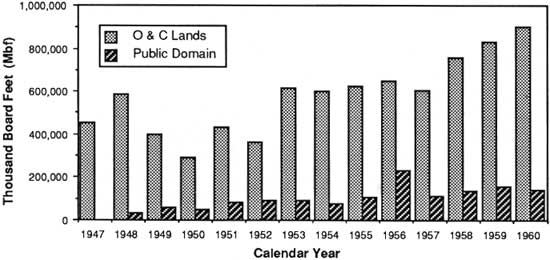
|
|
Timber production 1947-1960
|
|
|
BLM, therefore, continued the public domain timber
inventories initiated under Clawson, and they proved enlightening. BLM
found the extent of its public domain timber resources to be greater
than originally thought. Through the use of annual forestry plans, BLM
increased timber sales and accelerated reforestation efforts on these
lands.
|
|
|
Forestry efforts also progressed in Alaska. BLM's
1955 Alaska Report estimated the territory's 125 million acres of
forests and woodlands contained some 350 billion board feet of lumber.
Because Bureau policy called for maximum multiple use, the protection
and development of watersheds and timber resources, and protection
against insects, disease, and fire, BLM increased its forest inventory
and timber management planning in the territory.
|
|
Alaska
Timber |
|
The public domain timber program, like the range
management program, was limited in what it could accomplish. In 1957,
there were only 310 foresters supported by 100 nonprofessional and
seasonal employees, and most were assigned to the O&C. A few
forestry offices, like in Coeur d'Alene, Idaho, were opened to
administer public domain forests. However, most grazing districts, many
having extensive and valuable stands of pinyon-juniper and scrub oak,
continued to operate without foresters.
|
|
Timber
Program
Staffing |
|
FIRE PROTECTION AND SUPPRESSION
|
|
|
It was in the area of fire protection that BLM's forestry program in
Alaska made its most notable gains. When Woozley became Director,
Alaska's firefighting facilities and equipment consisted of military
surplus material, with aircraft being the most important part
of the firefighting arsenal. Airplanes gave fire crews mobility,
enabling them to quickly reach fires far away from highways. The Bureau
got three old Navy amphibian aircraft in 1953 and then supplemented them
with three conventional planes to transport crews and equipment. These
airplanes allowed BLM to expand its fire control efforts in the Alaskan
interior.
|
|
Alaska Fire
Program |
|
BLM learned the limitations of its firefighting
program in the territory when wildfires devastated Alaska in 1957. More
than 400 fires burned close to 5 million acres. One fire, the Kuskokwin
Fire, burned an area twice the size of Rhode Island. Damage to resources
was put at more than $7.7 million.
|
|

|
|
BLM administered land burned 1947-1960
|
|
|
After the 1957 fire season, BLM worked hard to
upgrade its Alaska fire program. Fire facilities were built at
Fairbanks, McGrath, and Central in 1958, and six others were planned.
The Bureau increased the number of fire weather stations. A fire rating
system was developed and employed. Air patrols were sent into areas
after lightning storms, and the use of aerial sodium borate drops,
effective against small fires, was expanded. But the Bureau's highest
priority was a smokejump installation in Fairbanks. In their first year
of operation in 1959, BLM's 15 smokejumpers made 109 successful jumps,
completely extinguishing 11 major fires.
|
|
|
BLM also improved firefighting efforts in the "Lower
48." The agency continued to contract fire protection for the 5 million
acres of public domain forests that were too far away from its district
offices. BLM also continued to install high-frequency radio networks in
all the western states to enhance response time and to coordinate fire
efforts. Pumper trucks became the backbone of grazing district
firefighting arsenals because, with them, two-member crews could
control 90 percent of the range fires. Aerial water drops further
enhanced the effectiveness of the pumper trucks.
|
|
Lower 48 Fire
Efforts |
|
By 1960, the Bureau's fire response times had been
reduced and fire suppression methods and equipment had been improved.
Better training of firefighting crews further enhanced the increasing professionalism of
BLM's firefighting program.
|
|
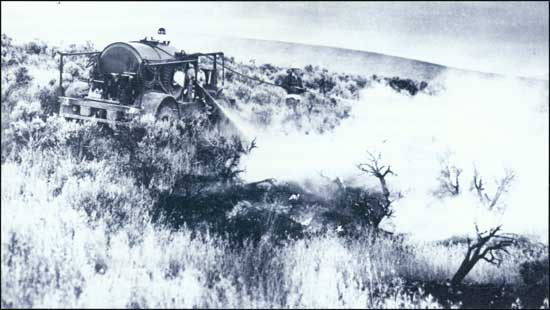
|
|
A tanker truck fighting a range fire in Idaho
|
|
|
WILDLIFE
|
|
|
The wildlife program continued to expand in
importance during Woozley's tenure. The Bureau's basic policy toward
wildlife was still concern for the habitat, and as Director Woozley
explained in 1955, "The management of wildlife [was] strictly on a basis
of cooperation between the BLM as the administrator of vast public land
acreages, supporting large wildlife populations, and the respective
states recognized as the owners of the wildlife."
|
|
Wildlife
Policy |
|
BLM gave wildlife interests more influence. In 1955,
the number of wildlife representatives on National Advisory Board
Council was increased from one to three members. Five years later,
nonprofit wildlife groups and organizations were allowed to nominate and
influence selection of candidates for wildlife positions on each of the
grazing district advisory boards. The nominees were referred to state
fish and game officials and then appropriate BLM State Offices for
consideration and approval.
|
|
Wildlife
Representation
on National
Advisory
Board
Council |
|
The range and forestry staffs became more involved in
wildlife management. Many BLM employees participated in wildlife census
work, game range studies, and other related work.
|
|
BLM Wildlife
Work |
|
Of the many wildlife issues that BLM managers faced,
the migration of antelope proved the most controversial. National and
local wildlife organizations expressed concern over how sheep-tight
fencing in Montana and Wyoming was preventing free movement of antelope.
BLM had to find a compromise that would protect the needs of ranchers,
yet address the antelope migration problem. Several years later, it
adopted a policy that would allow for fence construction in important
wildlife habitat areas only after proper safeguards for wildlife had
been made.
|
|
Antelope
Problems |
|
Wild horses also became an issue. When the Taylor
Grazing Act began operation, free-roaming horses were seen as a
nuisance. Horses are hard on rangeland, so large herds quickly
overgrazed areas. The Grazing Service and ranchers wanted to eliminate the
horses from grazing districts. During World War II, Secretary of the
Interior Harold Ickes had more than 77,000 of the animals removed from
the public lands to control their numbers but did not have the herds
totally removed.
|
|
Wild Horse
Issue |
|
In the late 1950s, free-roaming horses again became a
problem. The public had become increasingly aware of the horses and
believed they were wild descendents of the animals brought into the
Southwest by the first Spanish explorers. The linage of these horses,
however, only went back to animals abandoned earlier in the century when
horse prices declined and their use on farms and in the military faded
because of mechanization.
Wild horse groups wanted a national wild horse
refuge, but BLM officials called the idea unrealistic because of the
large areas the horses roamed. The Bureau did, however, support
protection if the horses became faced with extinction and backed a law
that prohibited roundups of abandoned horses and burros by airplanes and
motor vehicles in an effort to prevent the cruel treatment of these
animals.
|
|
|
RECREATION
|
|
|
As in the Clawson years, recreation continued to be
an important facet of the range and forest land use.
During Woozley's tenure, use of the public
lands for hiking, camping, and other forms of recreation
increased. Most of the recreational use was associated with hunting and
fishing.
|
|
Recreation
Use |
|
The Bureau recognized that "the need for additional
lands for public recreation purposes [was] a critical national problem."
So, in cooperation with the National Park Service, BLM began inventorying
and identifying public lands to determine which should be set aside for
recreational purposes.
|
|
Recreation
Inventory
Efforts |
|
Although the public lands had recreational potential,
the Bureau had little authority to develop and manage recreation areas.
With the few recreational responsibilities BLM was given by Congress,
the Bureau sought to protect, improve, and facilitate recreational
use.
|
|
|
In Alaska, the Public Works Act of 1949 allowed for
development of recreational sites on public lands. This effort was
furthered by a 1956 law permitting BLM to undertake
direct development of recreational sites in the
territory. By 1958, BLM had improved 47
sites and had identified 69 more projects. BLM, however, encouraged the
transfer of these sites to territorial and later to state agencies. In
1960, Secretary of the Interior Fred Seaton proposed that BLM be given
authority to improve sites on other parts of the public domain.
|
|
Recreation in
Alaska |
|
The basic Bureau recreational authority remained the
Recreation Act of 1926. In 1954, the law was amended to provide for the
lease and sale of public lands determined valuable for public purposes
such as waste disposal sites, cemeteries, and municipal water storage to
state and local governments and nonprofit associations and corporations.
Applications for sites under the new Recreation and Public Purposes Act
flooded BLM. The Bureau sold sites if the land had no multiple resource
values and leased the sites if the land had such values.
|
|
R&PP Act of
1954 |
|
The Bureau was able through the Recreation and Public
Purposes Act to protect not only areas having recreation potential but
also areas having historic values. BLM as early as 1953 became aware of
increased vandalism to cultural resource sites. District managers did
their best to police sites and investigate incidents, but to little
avail. BLM even tried to develop a management and protection program
with the help of the National Park Service, but the effort did little to
halt the destruction. The Recreation and Public Purposes Act, however,
specifically provided for the transfer of cultural resource sites, thus
allowing BLM to better protect these sites through transfers to the
states.
|
|
Protection
of
Cultural
Resources |
|
THE LANDS PROGRAM
|
|
|
The land hunger that followed World War II continued
with new fervor after the election of President Eisenhower. In fiscal
year 1953, more than 40,000 applications were filed and, the following
year, entries increased by more than 50 percent.
|
|
Land Boom |
|
Edward Woozley called the crush of applications
"unprecedented", though this boom paled when compared to past land
rushes. He attributed the marked increase to the nation's "high level of
economic activity...particularly...those sections of the country where
public lands make up a large part of the total land area." BLM also
pointed out that higher land values, increased risk capital, and
advances in technology made previously marginal and submarginal lands
attractive for development.
The new Republican Administration also spurred
activity. Republicans in Congress had long argued that the Department of
the Interior under Presidents Franklin D. Roosevelt and Harry S. Truman
had locked up the public lands. Eisenhower's first Secretary of the
Interior, Douglas McKay, agreed and felt many public lands could be
"more economically and satisfactorily administered" if transferred to
state or private ownership. Such talk undoubtedly fueled the land rush,
as speculators and others anticipated a great giveaway.
|
|
|
Giving away public lands, however, was not the intent
of the new administration. Public lands with important multiple resource
values were to be retained. Interior Department officials, however, felt
that land case processing could be simplified and modified regulations
to allow BLM to be more responsive and flexible when processing
entries.
|
|
BLM Land
Policy |
|
BLM continued the records improvement project
initiated by Clawson. In 1955, the Bureau introduced the
Master Title Plat and Historical Index system that remains
the basis of the Bureau's land and mineral status
records system today.
|
|
New Records
System |
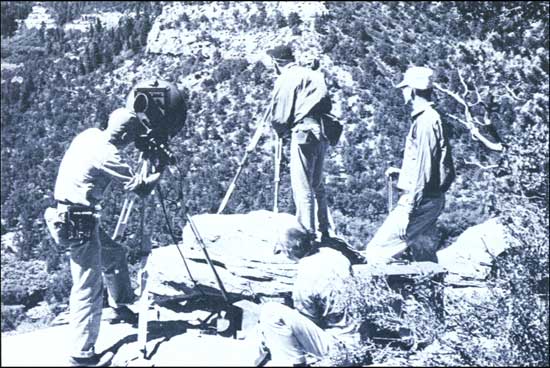
|
|
BLM surveying crews adopted use of electronic measuring devices in the
late 1950s. (BLM)
|
|
|
The Bureau also strove to make more public lands and
resources available for development and entry by revoking
withdrawals. Withdrawals were reviewed to determine if they
still fulfilled the purpose for which they
were established and if the resource values could be
protected by other management methods. BLM also got Congress to enact legislation
prohibiting the military from securing public land
withdrawals of more than 5,000 acres without Congressional authorization
and permitting the Bureau to manage the resources within the military
reserves. BLM was thus able to open up millions of acres of public land
to entry and to prevent millions more from being withheld.
|
|
Making Land
Available |
|
Surveys were also important to the Interior
Department's efforts to make lands available for use and development.
Resurveys were vital in properly marking public land boundaries for lease or
disposal. In addition, a significant amount of acreage in the "Lower 48" was
unsurveyed. Fifteen percent of the western United States, excluding
Alaska, had not been traversed by survey crews. These unsurveyed lands,
often rugged, mountainous, or desert in character, were wanted by states
to satisfy land grant selections. These lands, however, had timber and
mineral values that could not be sold or leased until surveys were
completed.
BLM also began using protracted survey sheets. Not
intended to replace on-the-ground surveys, protraction diagrams showed
section corners and lines of a township, as determined from aerial
photographs and other information sources. With these diagrams, BLM
could describe lease and disposal actions in unsurveyed areas by
township subdivision rather than by complicated metes-and-bounds
descriptions. The method was employed in Alaska with much success and,
by 1960, more than 284 million acres had been placed on protracted
diagrams. New Mexico, Arizona (of which 32 percent of the state was
unsurveyed), and Montana also began using the sheets.
|
|
Survey
Program |
|
Since survey appropriations were inadequate to meet
the demand, surveys had to be completed where demand was most
urgent. BLM looked for ways to speed the process. The efficiency of
crews improved with the use of helicopters to move surveyors and
equipment. Electronic measuring devices were introduced and so was the
use of photogrammetry, a method of employing photographs to determine
height and distance.
|
|
|
RECORDS IMPROVEMENT PROJECT
by Tom Adler
Management Analyst, BLM Service Center
The Records Improvement Project (RIP) was a special
program approved for the enhancement of the Land Office Records. In the
process of doing a "Land Office Business," the land records kept by the
Federal Government grew by leaps and bounds.
The process for tracking ownership of a piece of land
soon became a monumental task. As the volume of information expanded, so
did the space requirements to store these odd-shaped books and plats.
The land office records were very cumbersome to handle, difficult to
read, and only available at selected locations.
To research a case, a person would have to find the
proper books, and/or plats, remove them from the storage shelves and
find a vacant table to open them on. The documents for one case often
required the entire table top. The researchers soon found themselves
with over 10 million records to sift through in order to find their
required information.
In the mid-1950s, the Bureau issued several contracts
to correct the records problems: storage, readability, and retrieval of information.
The first State to receive the "New Records System" was Utah, followed
by New Mexico and Arizona.
The New Records System consisted of Master Title
Plats (MTPs), Use Plats, and Historical Indexes (HIs). The MTP, a
composite of approved Survey Plats for a Township replaced the GLO
Plats. Use Plats, copies of the MTP showing specific use activity,
replaced freehand mineral plats such as oil and gas leasing activity.
The HI, a chronological list of all land transactions in a given
Township, replaced the Tract Books. With this new system, users could
find title and use data at a glance, that previously would have required
hours of research.
This system has a master set of records (the working
copy) which is updated daily by the Records section at each State Office and copies that
are in the public room, District and Resource Area offices. Many other agencies also have
a copy of these new records.
The process to create the new records required that
each document be reviewed and abstracted to a standard form. The forms
were then sorted into files by township and the information hand drafted
to the new plats or typed on the HIs using special long carriage
typewriters. The material used for the new records was reproducible and
updatable.
Although this system is widely accepted and used
today, in the late 50s times were tough. The existing contractor went
broke and no one was willing to take over the task at hand. At this
time, BLM established an in-house Records Improvement Project. The
project goal was to continue to build the "New Records System" for other
western states and Alaska.
The RIP Project Office varied from 50 to 150
employees, each with specialized title records skills, who moved from
state to state, constructing the new records which were subsequently
reviewed and accepted by the State Office. This was a 2- to 3-year
process for each State.
California was the last state to receive the New
Records System and in 1984, the RIP Project Office was closed.
|

|
|
The reality of Small Tract Act (BLM)
|
|
|
The demand for land after 1953 seemed insatiable. No
matter how hard Bureau adjudicators worked, the
backlog of cases grew each year. Between 1953 and 1960, the number of unclosed case increased from
25,000 to more than 45,000.
|
|
Land Case
Backlog |
|
One cause of the land boom was Small Tract Act
applications. In 1954, the law was amended to include the sale or lease of
parcels to corporations, associations, and state and local
governments, as well as individuals. BLM praised the amendment for the flexibility it provided in
disposing of areas for residential, business, recreation, and community
purposes.
|
|
Small Tract
Act |
|
Land promoters were also responsible for the increase
in applications. They appealed to Americans' desire to acquire land
through newspaper and magazine advertisements across the nation. "Most
people [who make filings]," Director Woozley pointed out, "imagine
they'll get a cold stream, green grass, and all that. They are more
likely to end up with plain desert." But the applications came in and jumped from 13,000
in 1953 to 43,000 two years later.
|
|
|
The Desert Land Law was also troublesome. New
technological innovations like the electric pump permitted more
effective development of underground water sources. Low agricultural
commodity prices had kept interest in the law down, but, with improving
prices in the late 1950s, entries rose sharply. Desert Land Law cases
went from 1,300 in 1957 to nearly 4,000 the following year.
|
|
Desert Land
Law |
|
The heightened demand for public lands intensified
competition between applicants. Several applications were often filed
for the same parcel of public land. Resolving these controversies,
especially when tracts were wanted for different purposes, placed heavy
demands on BLM.
|
|
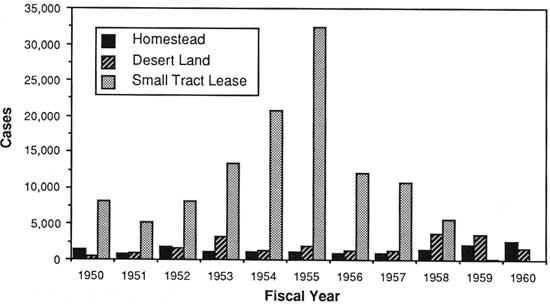
|
|
New land case action 1950-1960
|
|
|
Land classification helped resolve many of the
conflicts, especially where demand was high. BLM used it as a means of
controlling the growth and development of communities being created as a
result of Small Tract Act activity. With the Desert Land Law,
classification allowed BLM to determine whether the lands had good
agricultural soils and sufficient water supplies. If they did not,
applications could be rejected. BLM's land classification process
resulted in the rejection of two-thirds of the Desert Land Law entries
filed. The Bureau also imposed more stringent regulations and had land
locators prosecuted for fraudulent and misleading advertising.
|
|
Land
Classification
Efforts |
|
Land exchanges provided additional headaches. Woozley
felt that land exchanges with states and individuals allowed public
lands and resources to be more effectively utilized and managed.
Exchanges benefited the Bureau by allowing it to put together more
manageable land patterns. The Bureau, however, found that its exchange
procedures failed to adequately protect public interests. Land speculators and others
were able to acquire public lands through exchange at less than fair
market value. To protect against this, in 1960 the Department instituted
an antispeculation policy that ensured all land exchanges had a "clear
and positive benefit" to the federal government and that the lands
traded were of equal or near-equal value.
|
|
Land
Exchange
Problem |
|
A less troublesome situation was the Bureau's
disposal of public lands in the East. These lands were difficult to
manage. Most were isolated tracts with little public value. BLM wanted
to rid itself of the lands. The Bureau's Eastern States Office did so
through state indemnity selections, color-of-title claims, and public
sales.
|
|
Eastern
Public Lands |
|
In Alaska, the lands program emphasis shifted from
the Small Tract Act and Homestead Law, which remained popular, to
territorial and then state selections of public land. The first of the
extensive land grants came in 1956. In the Alaska Mental Health Act,
Congress provided the territory with a million acres to support mental
health programs and facilities. The land selected had to be vacant,
unappropriated, and unreserved and had to be used to support a mental
health program for Alaska. Two years later, Alaska was admitted to the
Union and a generous Congress granted the new state more than 103
million acres of public land.
|
|
|
The statehood grant lands posed a challenge for BLM.
The agency knew that Alaska would select the best public lands from the
standpoint of resources and economic development potential, curtailing
many of the Bureau's plans for these lands. The situation, therefore,
called for BLM to work closely with state officials to ensure orderly
state land selections and public land resource development. Alaska
officials began their selection of lands in 1959 and, by the next year,
had selected nearly 6.5 million acres. In the years to follow, the State
of Alaska's land selections would become one of the Bureau largest and
more troublesome programs.
|
|
Alaska State
Land
Selection |
|
MINERALS
|
|
|
Developments in the minerals program mirrored those
occurring in other resource areas. Under Woozley, BLM encouraged the
exploration and development of both public domain and
acquired mineral estates through private sector efforts. Minerals were
an important source of revenue for the federal government. In 1953, of the $66.8 million BLM
took in, $49.2 million came from royalties, rentals, and bonuses
paid under the Mineral Leasing Act of 1920.
|
|
Mineral
Revenues |
|
Most mineral revenues received in 1953 came from oil
and gas leasing. Oil and natural gas had replaced coal as the nation's
main energy fuel, and the increased consumption pushed
petroleum companies to expand their exploration efforts. In 1953, Woozley
reported 78,000 oil and gas leases covering 60 million acres of public
domain and 2,000 leases covering 1.8 million acres of acquired lands.
The figures rose by 1960 to more than 140,000 oil and gas leases on
nearly 116 million acres of public domain and nearly 6,800 leases on
close to 5 million acres of acquired lands.
|
|
Oil & Gas
Activity |
|
EASTERN STATES OFFICE
by Curt Jones
State Director
Since the bulk of the BLM-administered public lands
are located in the West, the Bureau's role in the 31 eastern states is
hardly traditional. But, in addition to operating the largest land title
business in the country through the General Land Office records, the
Eastern States Office also deals with a broader variety of minerals and
a more complex mix of mineral ownerships than any other office in the
Bureau.
When BLM received operational responsibilities for
Federal onshore minerals, the Eastern States Office (ESO), established
in 1954, took on a presence in the field far beyond any previous one.
Our mineral operations inspectors use boats and helicopters to reach oil
and gas leases in the Louisiana bayous, check phosphate operations in
the piney woods of Florida, travel miles through deep lead and zinc
mines in the Missouri Ozarks, and monitor the environmental aspects of
quartz mining in Arkansas. These field operations are managed out of our
two District Offices established in 1983 in Jackson, Mississippi and
Milwaukee, Wisconsin.
And since 1976, when Congress amended the Mineral
Leasing Act to allow leasing within military installations, ESO issued
oil and gas leases on nearly a dozen military areas and is exploring
leasing potential on a number of others. Since these are all acquired
lands, the leasing complexities are magnified.
The Eastern United States has become the primary
marketing area for wild horse and burro adoptions. To support this
effort, we have established distribution centers at Lewisberry,
Pennsylvania, Cross Plains, Tennessee, and at London, Ohio. We hold
around 30 adoption events annually, and it is not unusual for 150 or
more animals to be adopted at a single event.
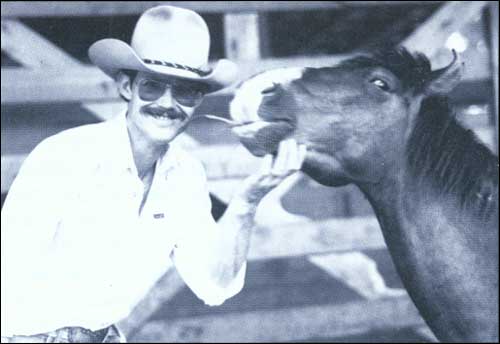
Wild horse adopter at BLM Distribution Center, Lewisberry, PA. (Denise
Meridith)
ESO maintains close ties with state land and
resource agencies, and with their umbrella organization, the Eastern
Lands and Resources Council, which we helped establish in 1984. Through
cases that require resurveys and/or site-specific legislation to clear
up ownership issues of long standing, we are providing vital services to
many Americans in the largest and most populous region of the United
States.
|
|
|
Petroleum companies were particularly interested in
Alaska's oil and gas potential. Much of this interest was prompted by
BLM reports in 1953 indicating oil and gas on the Kenai Peninsula near
Anchorage and at other locations.
|
|
|
Alaska's first discovery, however, did not come until
1957 at Swanson River on the Kenai Peninsula. Oil and gas leases in
Alaska then jumped from 3,385 to more than 9,000. To
handle the crush of lease applications, the BLM in Alaska had to temporarily assign people
from other mineral programs, as well as from fire and forestry staffs,
to help process the workload.
|
|
Alaska Oil
Boom |
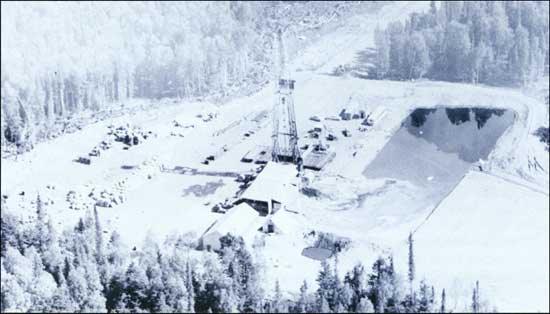
|
|
Alaska's first successful oil well—1957 (BLM)
|
|
|
Secretary of the Interior Fred Seaton further spurred
activity by opening 20 million acres in northern Alaska previously closed
to leasing. After this was done, leasing was resumed. In 1959, 16,000 acres
of land adjacent to a known natural gas field were leased at competitive
sale for more than $200,000. A year later, nearly 34 million acres of
public lands in Alaska were under lease—more than for any other public
land state.
|
|
|
BLM not only had the oil boom to contend with, but
also the problems associated with speculation that had first surfaced
during Clawson's tenure. By eliminating of 40-acre leases outside of producing
areas, some of the problems had been solved, but
leasing firms then turned to selling 40-acre
assignments—subleases—of existing leases. More than 28,000
assignments were filed in 1958, causing the processing of new lease
offers to slow down dramatically. BLM attempted to stop the practice,
which was legal, with legislation prohibiting assignments of less than
160 acres. Since Congress took no action, the problem persisted for the
remainder of Woozley's tenure.
|
|
Speculation |
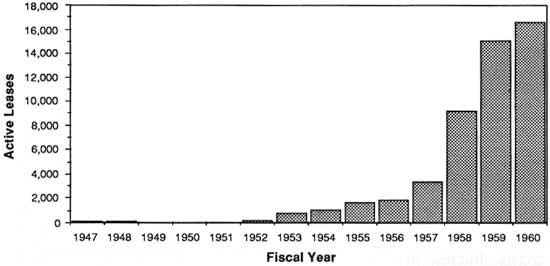
|
|
Active oil & gas leases in Alaska 1947-1960
|
|
|
BLM under Woozley did resolve one problem associated
with oil and gas leasing. As interest in obtaining oil and gas leases
intensified, the public was competing more and more for leases that were
cancelled, relinquished, or terminated. To ensure everyone would get a
fair and equal chance to know about and obtain these leases, BLM in 1960
instituted a simultaneous filing system. The new procedure required all
oil and gas leases that had been cancelled, relinquished, and terminated
during one month to be publicly listed for 5 days the following month.
Prospective lessees could then file applications for those tracts that
interested them. Leases were then awarded by public drawing. This
process became popularly known as the oil and gas lottery system.
|
|
Simultaneous
Filing System |
|
The real oil boom, however, was not on the public
lands; it occurred off the nation's coastline. As early as 1865, the
Surveyor General of California reported a petroleum spring on the ocean
floor near San Luis Obispo. However, these petroleum reserves were not
seriously developed until the 1930s. In that same decade, oil was
discovered in the Gulf of Mexico near the Louisiana and Texas
coasts.
|
|
Outer
Continental
Shelf |
|
The federal government and states argued over the
ownership of the valuable offshore lands. The U.S. Supreme Court in 1947
sided with the federal government against California and, 3 years later,
against Texas and Louisiana. States' rights advocates were incensed and
sought support from the Republican Party in their bid to "return" the
submerged lands to the states. With Eisenhower's election, Congress
quit-claimed all the federal interest in tideland and seabed areas 3
miles from the coastline to the states.
The federal government, however, retained title to
the area beyond the 3-mile limit. Known as the Outer Continental Shelf,
this area was thought to have much of the 12.5-billion barrel oil
potential attributed to offshore lands. BLM was assigned the
responsibility for leasing this area through competitive sales, while
the Geological Survey was to oversee prospecting and development.
Texas and Louisiana were considered to have the best
oil and gas potential, so in 1954 BLM's Eastern States Office was
directed to open an office in New Orleans. BLM then began taking
nominations for tracts to be offered and put them up for bid. The bonus
bids received for lease of the parcels exceeded $150 million—twice
that of BLM's best expectations.
The Outer Continental Shelf quickly established
itself as a moneymaker. In 1955 the first discovery off Louisiana
produced 595 barrels a day. More impressive was the fact that leasing
the Outer Continental Shelf brought in more than $252 million in bonus
bids and rentals within the first year. All lease offerings were
suspended in 1956 when Louisiana and the United States went to court to
determine the 3-mile boundary between their jurisdictions. In 1959, BLM
resumed leasing off the Florida coast. A year later, after the U.S.
Supreme Court had ruled on the boundary issue, BLM also resumed leasing
along the Louisiana and Texas coasts. Interest in the Outer Continental
Shelf had not waned; BLM received more than $370 million for 1.2 million
acres offered.
|
|
|
Enactment of new minerals legislation also occurred
during the Woozley era. Multiple Mineral Development Act of 1954
provided for the location of mining claims under the General Mining Law
and leasing under the Mineral Leasing Act on the same tract. Before the
law was enacted, mining claims could not be staked on lands leased for
oil and gas or other minerals, nor could mineral leases be issued for
lands covered by valid mining claims. The new law permitted multiple
development of minerals on the public lands.
|
|
Multiple
Mineral
Development
Act of 1954 |
|
The Multiple Surface Use Act of 1955 restricted
surface use rights on unpatented mining claims. The federal government
could, after following detailed procedures intended to protect the
interests of miners, classify and open surface resources on mining
claims to Federally supervised grazing, timber cutting, and other uses.
The 1955 law also provided for the disposal of sand, gravel, stone, and
other common variety minerals through sale under the Materials Act of
1947. This removed these minerals from location under the General Mining
Law of 1872 and made administration easier for the Bureau.
|
|
Multiple
Surface Use
Act of 1955 |
|
INTERNATIONAL ASSISTANCE PROGRAM
|
|
|
As an outgrowth of its increasing resource management
responsibilities and professionalism, the Bureau of Land Management began sharing its
knowledge and expertise with other nations. The social and economic
problems facing many countries, particularly those now known as the Third
World, often resulted from the improper and unbalanced use, management,
and distribution of land. BLM worked with many nations to alleviate
these problems as part of the United States' foreign assistance program
after World War II.
|
|
Third World
Program |
|
Beginning with Clawson during the Truman Administration, the
Bureau began sending various technical experts to foreign lands and hosting
their professionals in the United States. Director Woozley continued the
program. By 1960, BLM had assisted Egypt, Paraguay, West Germany,
the Philippines, and many other countries with cadastral survey, land
classification, range and forestry administration, and many other land
and resource management activities.
|
|
BLM
Outreach |
|
THE FIVE-POINT CONSERVATION PROGRAM AND PROJECT
2012
|
|
|
Near the close of the Eisenhower Administration, the
Department of the Interior and the Bureau of Land Management began to
work on an ambitious new conservation program for the public lands. The
program called for intensified resource management to respond to the
nation's growing population and increasing demands on natural resources.
Resources would have to be conserved through more efficient use that
would reduce waste and damage. The recycling and salvaging of resources
would become more important.
|
|
|
In line with this thinking, the Interior Department
sponsored a five point program aimed at accomplishing better
conservation of the public lands and resources. Enacted by Congress in
1960, the Public Lands Administration Act called for (1) using forfeited
timber deposits to rehabilitate lands ruined by defaulting timber
contractors, (2) receiving sufficient deposits from users of BLM roads
and trails to ensure proper maintenance, (3) charging more realistic
fees for services rendered by BLM, (4) accepting donations for the
improvement or management of public lands and resources, and (5)
entering into cooperative agreements with others in order to carry out
proper management of public lands and resources.
|
|
Five-point
Program |
|
BLM at the same time proposed its own ambitious
conservation program. The plan was called Project 2012. In sending the
prospectus to the President, Secretary of the Interior Fred Seaton
emphasized that the plan sought to meet the nation's "accepted goals of
conservation, improvement, wise use and development of our public
lands," while at the same time, contributing "toward meeting the
challenge of our growing population and expanding economy."
|
|
Project 2012 |
|
Project 2012 was the Bureau's first attempt at a
comprehensive, long range program for the public lands. It addressed the
"orderly, efficient, and sound development and use of resources...through
balanced, coordinated, and sustained effort" over a 50-year
timeframe. The program was ambitious but unrealistic. As Bob Jones, a
BLM employee who worked on the plan, recalls, "The primary legacy of
[Project] 2012 was to create an internal awareness of possible
long-range resource management program needs and dimensions along with a
healthy skepticism of the value of 50-year detailed program
projections." More important, as professor of natural resources Sally
Fairfax points out, the Project 2012 report, though "unexceptional" in
her opinion, reflected "the maturation of an increasingly professional
BLM staff."
|
|
Professionalism
Established |
|
Project 2012 was quickly forgotten by BLM and the
public. The agency's professionalism, however, did not disappear. The talent and
skills developed during the 1950s continued on and were to be put to
good use by a new administration with a "New Conservation"
agenda.
|
|
Bureau of Land Management
1946-1960
|
| Employees |
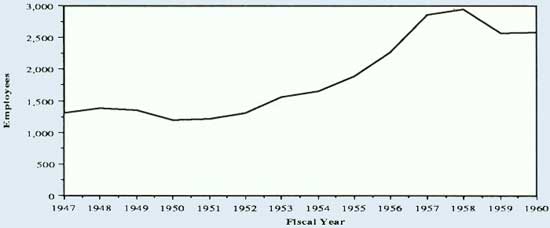 |
| Budget |
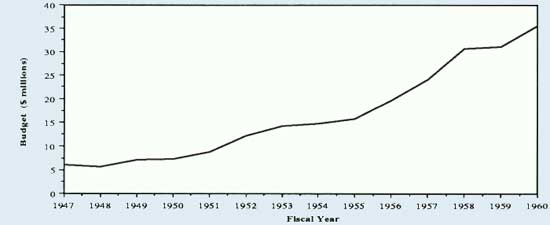 |
| Revenues |
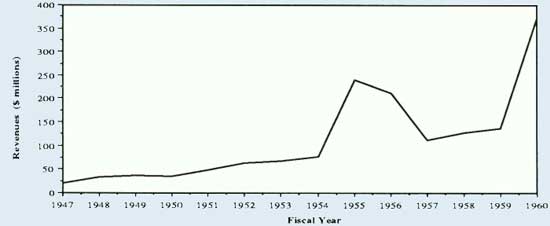 |
| Directors |
| Fred Johnson | 1946-1948 |
| Marion Clawson | 1948-1953 |
| Edward Woozley | 1953-1961 |
|
Major
Legislation |
| Materials Act | 1947 |
| Outer Continental Shelf Act | 1953 |
| Multiple Minerals Development Act | 1954 |
| Multiple Surface Use Act | 1955 |
|
|
|
|
FURTHER READINGS |
|
|
Historians have largely ignored the Bureau of Land Management. What
little has been written has been by political scientists, economists,
and natural resource management specialists.
General overviews of the 1950s that give some reference to BLM are
Samuel T. Dana's and Sally K. Fairfax's, Forest and Range Policy:
Its Development in the United States, Second Edition (1980), and
Elmo Richardson's, Dams, Parks & Politics: Resource Development
and Preservation in the Truman-Eisenhower Era (1973). Treatments that
touch upon BLM in the early '50s are Charles McKinley's, Uncle Sam in
the Pacific Northwest (1952), and E. Louise Peffer's, The Closing of
the Public Domain: Disposal and Reservation Policies, 1900-50 (1951).
On BLM under Director Marion Clawson, see his "Reminiscences of the
Bureau of Land Management, 1947-1953," in The Public Lands:
Studies in the History of the Public Domain (1962) edited by Vernon
Carstensen, and his autobiography, From Sagebrush to Sage: The Making
of a Natural Resource Economist (1987). Marion Clawson's The
Bureau of Land Management (1971) provides some background
information.
Useful to understanding the early organization of BLM is Eugene D.
Hart's, "The Field Organization of the Bureau of Land Management,"
Ph.D. dissertation, American University, 1957.
General studies of public land resource administration are Marion
Clawson's and Burnell Held's, The Federal Lands: Their Use and
Management (1957), and Marion Clawson, The Federal Land Since
1956: Recent Trends in Use and Management (1967).
Range policy is well handled in Wesley Calef's Private Grazing
and Public Lands: Studies of the Local Management of the Taylor Grazing
Act (1960), and J. Russell Penny's and Marion Clawson's, "Administration
of Grazing Districts" in The Public Lands: Studies in the History of the
Public Domain (1962) edited by Vernon Carstensen. Also of use are Phillip
O. Foss, Politics and Grass: The Administration of Grazing on the
Public Domain (1960), and William Voigt, Jr., Public Grazing Lands: Use
and Misuse by Industry and Government (1976).
As to forestry, only the O&C lands have been adequately treated. On
the O&C, refer to Elmo Richardson's, BLM's Billion-Dollar
Checkerboard: Managing the O&C Lands (1980) and the The O&C Lands
(1981) by the University of Oregon's Bureau of Governmental Research and Service. On
BLM's development of a firefighting organization, see Stephen J.
Pyne's comprehensive fire history, Fire in America: A Cultural
History of Wildland and Rural Fire (1982).
Mineral policy and development is discussed in Robert Swenson's
"Legal Aspects of Mineral Resources Exploitation" in Paul Wallace
Gates' History of Public Land Law Development (1968), and Cad Mayer's
and George Riley's, Public Domain—Private Dominion: A History of
Public Mineral Policy in America (1985). On the issue of offshore oil and
gas, refer to Ernest Bartley's, The Tidelands Controversy (1953) and Chapter
9 of William K. Wyant's Westward in Eden: The Public Lands and the
Conservation Movement (1982).
On Alaska, see Hugh A. Johnson's and Harold T. Jorgenson's, The
Land Resources of Alaska (1963), and 'Promised Land:' A History
of Alaska's Selection of Its Congressional Land Grants (1987).
|
|
chap2.htm
Last Updated: 08-Sep-2008
|
